Olivia-Petra Coman's Blog, page 25
September 4, 2019
Plusuri şi minusuri din Delta noastră
Greu mă urnesc atunci când e să scriu despre aspecte negative din călătoriile mele.
Uneori, însă, e musai.Funda roz pe care-o aplic mereu ia, de această dată, forma plusurilor, menite să echilibreze balanţa timpului petrecut în Deltă.
În a doua jumătate a lui august, ne-am reîntors în Deltă, după 15 luni de pauză [de la sfârşit de aprilie, anul trecut]. Îmi fusese tare dor – ştiu că şi lui Marcel.Am condimentat un pic călătoria cu un drum în partea ucraineană a Deltei, dar seara Zilei nr. 2 ne-a prins în Galaţi.Clasicul drum cu bacul (23 lei = 20 lei -maşina- +2x1.50 lei -pasagerii-) a fost de această dată în lumina lunii -plus-, însă, după drumul spre Parcheş, am ajuns la Păduricea noastră de stejari, unde-am trăit atâtea momente frumoase, şi la primul minus. Ca niciodată, era plină de gunoaie. L

Alte minusuri* La Parcheş am găsit din nou gunoaie pe mal – nu atât de multe ca în alte zone din Deltă –, dar şi în apă. Pe durata turei noastre de dimineaţă, am reperat bidoane de plastic şi doze de bere, pe care le-am strâns în caiace la întoarcere. [Am plecat cu multe gunoaie în maşină şi, în drum spre Tulcea, am poposit pe la un punct de reciclare. Dacă ar strânge fiecare vizitator fie şi un bidon, să pluteşti pe apă / să ajungi la ea ar fi şi mai încântător!]
* Tulcea, care este unul dintre oraşele mele preferate din România, parcă arată tot mai rău, de la an la an. Lipsă de atenţie la detalii, mizerie pe trotuare şi în spaţiile verzi, faleza – cu un potenţial extrem de mare, de altfel – în paragină. [Este un oraş neîngrijit şi ar putea arăta fantastic! Autorităţile ar trebui să se ocupe şi să îi ofere o faţă nouă oraşului – gândiţi-vă doar că, la mijloc de august, spaţiile de cazare erau 98% ocupate; deci, lumea vine pentru că are ce să vadă în împrejurimi.]
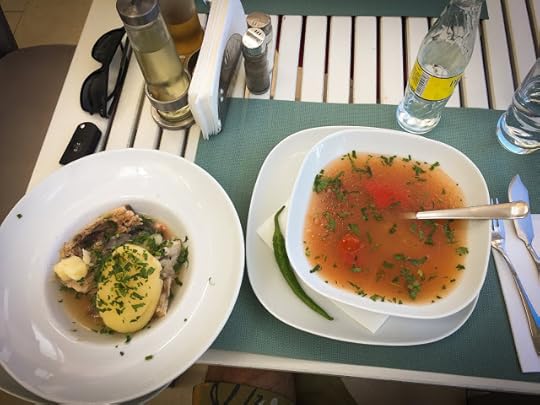
* În următorul minus există şi un plus – faptul că, în sfârşit, drumul ce face dreapta imediat după postul de verificare acte (de după trecerea cu bacul Tulcea-Tudor Vladimirescu) s-a deschis. Aşadar, nu a mai fost nevoie ca Marcel să conducă până-n Pardina. Partea proastă – şi mi s-a rupt sufletul – a fost că multe dintre persoanele care veniseră în zonă să pescuiască nu îşi strânseseră gunoiul. În cazurile fericite, pungile erau atârnate în copaci (!). În cazurile nefericite şi incredibil de scârboase, erau fie împrăştiate prin locul respectiv, fie prin tufele din spate. [Nu mai frumos este să strângem după noi şi să îi lăsăm şi pe alţii să se bucure de splendoarea din Deltă? Ca să nu mai vorbim că este un sit UNESCO, protejat...]
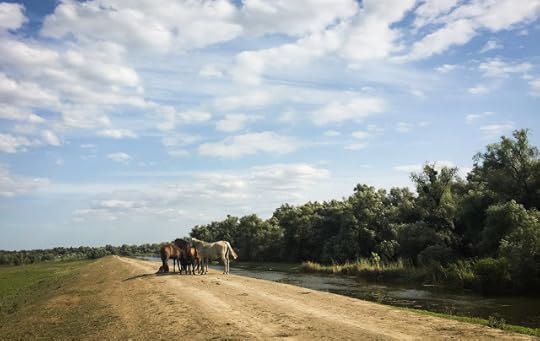
Alte plusuri* Nici în acest an, unul dintre locurile mele preferate din lume nu m-a dezamăgit. Nu ne-a dezamăgit. Aceeaşi linişte, aceeaşi umbră de-a lungul apei, aceeaşi multitudine de păsări. „Uite, mic, un pelican!” În fiecare an îi vedem aici. Până să se întoarcă Marcel (eram cu caiacele pe apă), a mai văzut „o jumătate de pelican”. Ne-am lăsat să cădem într-o relaxare aproape totală, ne-am întins pe spate în caiace şi am ascultat păsările.
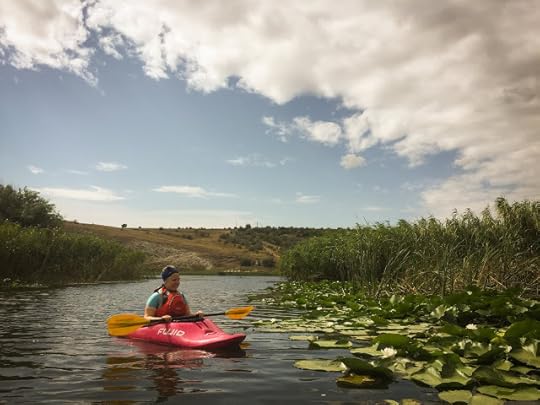
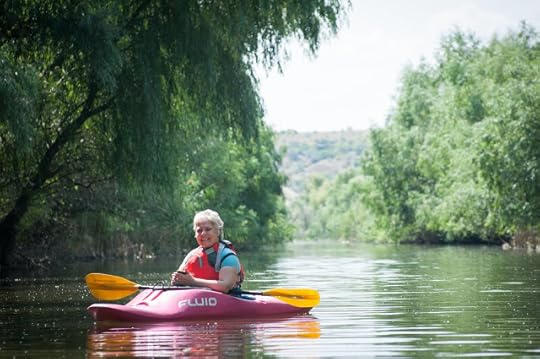
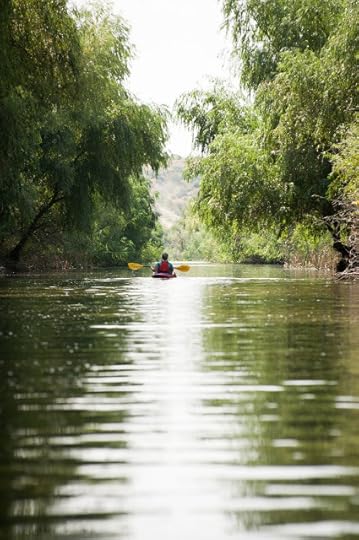
* Marcel a primit un somn, fără niciun ban, de la un localnic. Tare mult s-a bucurat şi şi l-a gătit în chiar seara aceea. A fost o adevărată aventură, i-am luat gheaţă, să nu se strice. :D

* Pe Lacul cu Coteţe, am avut parte de un adevărat festin. Anul acesta, nu numai că am văzut o grămadă de pui de lebădă, atât de simpatici cu puful lor griuliu, dar am fost faţă în faţă cu poate cel mai mare număr de pelicani pe care l-am văzut vreodată. Ne-au lăsat să ne apropiem destul de mult, fără să se sperie, şi mult timp am fost doar noi doi şi ei, în timp ce alţi pelicani exersau zborul la înălţime, desenând figurine speciale pe cerul de toamnă. Da! Am mai spus-o, a fost prima dată când am simţit că am fost toamna în Deltă.
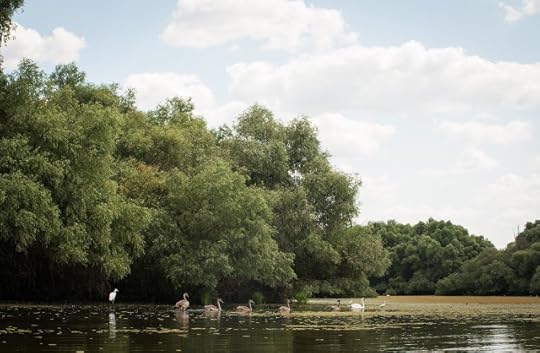
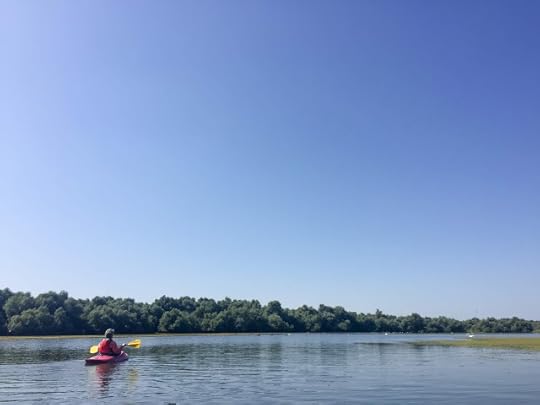
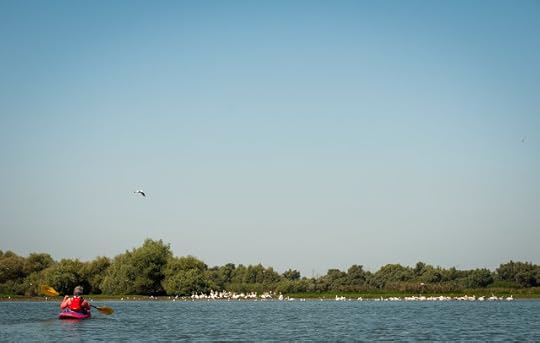

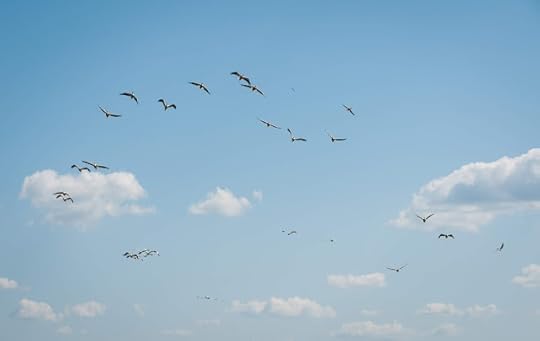
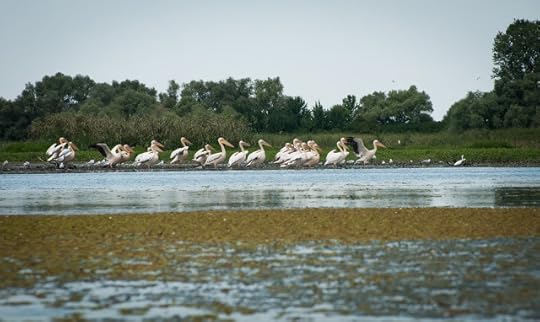
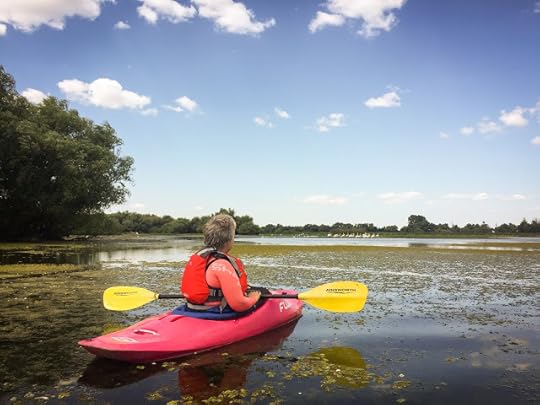
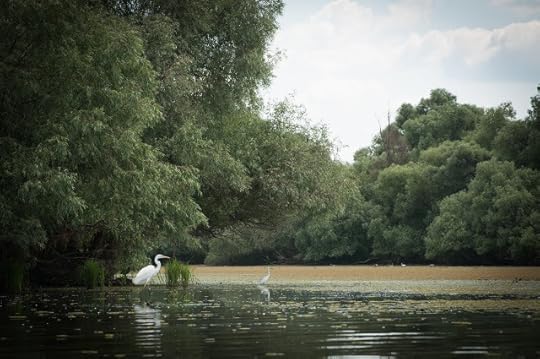
* Erau multe maşini la trecerea dinspre Tudor Vladimirescu înspre Tulcea, aşa că cei de la bac (23 lei = 20 lei -maşina- +2x1.50 lei -pasagerii-) au fost drăguţi şi nu ne-au lăsat prea mult să aşteptăm. Ca bonus, drumul apucat, spre Hârşova (taxă de pod, tot 11 lei), a fost la fel de pitoresc, la fel cum mi-l aminteam.
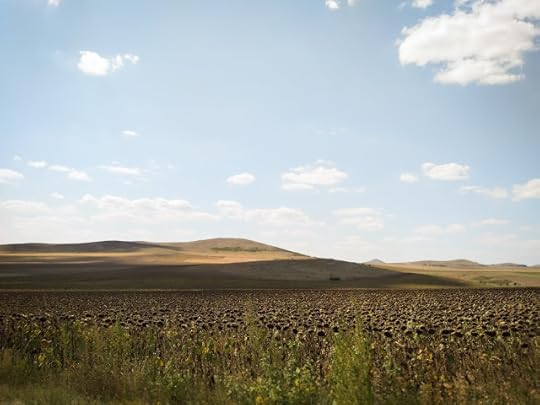
* Am apucat-o pe Cheia, căci pe Buşteni creşteau minutele de staţionare (Waze). Păruse că şi alţii avuseseră aceeaşi idee – cred, ca glumă, că am văzut maşini din aproape toate judeţele ţării, mai puţin Caraş-Severin, Gorj, Mehedinţi, Satu Mare, Vaslui. Vă daţi seama ce încet se conducea, dacă am apucat să le reperăm... măcar nu am stat pe loc. Şi încă ceva... românii umblă mult.
Revenind la oile noastre, aş vrea să atrag atenţia asupra altor locuri în care-am găsit gunoaie peste gunoaie:- Acum un an am fost scurt până la mare, în Bulgaria şi la noi, cu Marcel şi cu tatăl meu; undeva pe drumul spre faimoasa Cherhana Taşaul [un pic prea lăudată, în opinia mea], am dat peste imaginea asta şi mi s-a rupt sufletul. Nu, nu era o groapă de gunoi amenajată.
 - În noiembrie anul trecut am prins o duminică frumoasă-foc şi o lumină de apus memorabilă la Peştera, tot cu Marcel şi cu tata. Partea proastă este că am trecut şi pe lângă adunătura aceasta de gunoaie.
- În noiembrie anul trecut am prins o duminică frumoasă-foc şi o lumină de apus memorabilă la Peştera, tot cu Marcel şi cu tata. Partea proastă este că am trecut şi pe lângă adunătura aceasta de gunoaie.
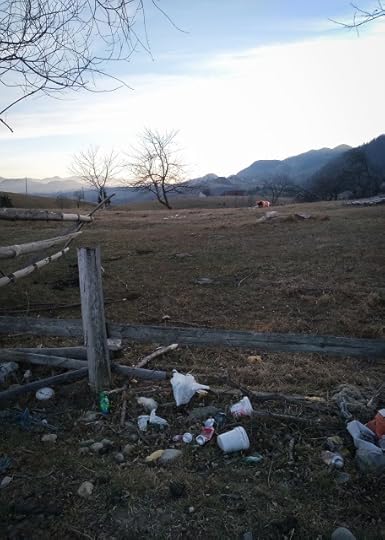
Mă deranjează tare de tot gunoiul. Mă întreb cum de pe alţii nu îi deranjează. Cum o fi să te lase sufletul să arunci până şi un şerveţel pe jos? Pe de altă parte, cum o fi să fie curat? În natură, pe ape, peste tot în lume. Sunt prea idealistă, aşa cred şi eu, dar ne putem apropia de ţinta aceasta. Încetul cu încetul. Şi ne putem ţine casa curată. Planeta noastră. ♥
Uneori, însă, e musai.Funda roz pe care-o aplic mereu ia, de această dată, forma plusurilor, menite să echilibreze balanţa timpului petrecut în Deltă.
În a doua jumătate a lui august, ne-am reîntors în Deltă, după 15 luni de pauză [de la sfârşit de aprilie, anul trecut]. Îmi fusese tare dor – ştiu că şi lui Marcel.Am condimentat un pic călătoria cu un drum în partea ucraineană a Deltei, dar seara Zilei nr. 2 ne-a prins în Galaţi.Clasicul drum cu bacul (23 lei = 20 lei -maşina- +2x1.50 lei -pasagerii-) a fost de această dată în lumina lunii -plus-, însă, după drumul spre Parcheş, am ajuns la Păduricea noastră de stejari, unde-am trăit atâtea momente frumoase, şi la primul minus. Ca niciodată, era plină de gunoaie. L

Alte minusuri* La Parcheş am găsit din nou gunoaie pe mal – nu atât de multe ca în alte zone din Deltă –, dar şi în apă. Pe durata turei noastre de dimineaţă, am reperat bidoane de plastic şi doze de bere, pe care le-am strâns în caiace la întoarcere. [Am plecat cu multe gunoaie în maşină şi, în drum spre Tulcea, am poposit pe la un punct de reciclare. Dacă ar strânge fiecare vizitator fie şi un bidon, să pluteşti pe apă / să ajungi la ea ar fi şi mai încântător!]
* Tulcea, care este unul dintre oraşele mele preferate din România, parcă arată tot mai rău, de la an la an. Lipsă de atenţie la detalii, mizerie pe trotuare şi în spaţiile verzi, faleza – cu un potenţial extrem de mare, de altfel – în paragină. [Este un oraş neîngrijit şi ar putea arăta fantastic! Autorităţile ar trebui să se ocupe şi să îi ofere o faţă nouă oraşului – gândiţi-vă doar că, la mijloc de august, spaţiile de cazare erau 98% ocupate; deci, lumea vine pentru că are ce să vadă în împrejurimi.]

* În următorul minus există şi un plus – faptul că, în sfârşit, drumul ce face dreapta imediat după postul de verificare acte (de după trecerea cu bacul Tulcea-Tudor Vladimirescu) s-a deschis. Aşadar, nu a mai fost nevoie ca Marcel să conducă până-n Pardina. Partea proastă – şi mi s-a rupt sufletul – a fost că multe dintre persoanele care veniseră în zonă să pescuiască nu îşi strânseseră gunoiul. În cazurile fericite, pungile erau atârnate în copaci (!). În cazurile nefericite şi incredibil de scârboase, erau fie împrăştiate prin locul respectiv, fie prin tufele din spate. [Nu mai frumos este să strângem după noi şi să îi lăsăm şi pe alţii să se bucure de splendoarea din Deltă? Ca să nu mai vorbim că este un sit UNESCO, protejat...]

Alte plusuri* Nici în acest an, unul dintre locurile mele preferate din lume nu m-a dezamăgit. Nu ne-a dezamăgit. Aceeaşi linişte, aceeaşi umbră de-a lungul apei, aceeaşi multitudine de păsări. „Uite, mic, un pelican!” În fiecare an îi vedem aici. Până să se întoarcă Marcel (eram cu caiacele pe apă), a mai văzut „o jumătate de pelican”. Ne-am lăsat să cădem într-o relaxare aproape totală, ne-am întins pe spate în caiace şi am ascultat păsările.



* Marcel a primit un somn, fără niciun ban, de la un localnic. Tare mult s-a bucurat şi şi l-a gătit în chiar seara aceea. A fost o adevărată aventură, i-am luat gheaţă, să nu se strice. :D

* Pe Lacul cu Coteţe, am avut parte de un adevărat festin. Anul acesta, nu numai că am văzut o grămadă de pui de lebădă, atât de simpatici cu puful lor griuliu, dar am fost faţă în faţă cu poate cel mai mare număr de pelicani pe care l-am văzut vreodată. Ne-au lăsat să ne apropiem destul de mult, fără să se sperie, şi mult timp am fost doar noi doi şi ei, în timp ce alţi pelicani exersau zborul la înălţime, desenând figurine speciale pe cerul de toamnă. Da! Am mai spus-o, a fost prima dată când am simţit că am fost toamna în Deltă.








* Erau multe maşini la trecerea dinspre Tudor Vladimirescu înspre Tulcea, aşa că cei de la bac (23 lei = 20 lei -maşina- +2x1.50 lei -pasagerii-) au fost drăguţi şi nu ne-au lăsat prea mult să aşteptăm. Ca bonus, drumul apucat, spre Hârşova (taxă de pod, tot 11 lei), a fost la fel de pitoresc, la fel cum mi-l aminteam.

* Am apucat-o pe Cheia, căci pe Buşteni creşteau minutele de staţionare (Waze). Păruse că şi alţii avuseseră aceeaşi idee – cred, ca glumă, că am văzut maşini din aproape toate judeţele ţării, mai puţin Caraş-Severin, Gorj, Mehedinţi, Satu Mare, Vaslui. Vă daţi seama ce încet se conducea, dacă am apucat să le reperăm... măcar nu am stat pe loc. Şi încă ceva... românii umblă mult.
Revenind la oile noastre, aş vrea să atrag atenţia asupra altor locuri în care-am găsit gunoaie peste gunoaie:- Acum un an am fost scurt până la mare, în Bulgaria şi la noi, cu Marcel şi cu tatăl meu; undeva pe drumul spre faimoasa Cherhana Taşaul [un pic prea lăudată, în opinia mea], am dat peste imaginea asta şi mi s-a rupt sufletul. Nu, nu era o groapă de gunoi amenajată.
 - În noiembrie anul trecut am prins o duminică frumoasă-foc şi o lumină de apus memorabilă la Peştera, tot cu Marcel şi cu tata. Partea proastă este că am trecut şi pe lângă adunătura aceasta de gunoaie.
- În noiembrie anul trecut am prins o duminică frumoasă-foc şi o lumină de apus memorabilă la Peştera, tot cu Marcel şi cu tata. Partea proastă este că am trecut şi pe lângă adunătura aceasta de gunoaie.
Mă deranjează tare de tot gunoiul. Mă întreb cum de pe alţii nu îi deranjează. Cum o fi să te lase sufletul să arunci până şi un şerveţel pe jos? Pe de altă parte, cum o fi să fie curat? În natură, pe ape, peste tot în lume. Sunt prea idealistă, aşa cred şi eu, dar ne putem apropia de ţinta aceasta. Încetul cu încetul. Şi ne putem ţine casa curată. Planeta noastră. ♥
Published on September 04, 2019 14:16
August 29, 2019
The hypocrisy of social media
It’s been a piece in progress for many weeks; yup, I find it hard to write about things that I don’t like and here’s a slice of pretence straight out of social media’s oven. Those who feel and see the real world [and I am grateful to be one of them!] may smile at the following practices, which doesn’t mean that they fall prey to them or encourage them. It simply means being polite when others are not.
Pictures[image error] You will surely agree: pictures with children beat all other achievements.Why? Almost every person can have a child, but not all of us can ice climb.[image error] When somebody posts a picture in a place that’s familiar to many people and not really niche, there’s a whole bunch of thumbs up and hearts involved. Even though the nichepicture is ten times more beautiful or special, it will most surely remain in the shadows.People tend to validate themselves through others, so a picture of, say, Rome would surely be more popular than one of Tehran because more users have experienced it.
![Café scene in Tehran, Iran [taken from Instagram]](https://i.gr-assets.com/images/S/compressed.photo.goodreads.com/hostedimages/1567197666i/28076247._SY540_.jpg) Café scene in Tehran, Iran [taken from Instagram]
Café scene in Tehran, Iran [taken from Instagram]
Posts[image error] Well, it doesn’t really matter whether you’ve climbed Everest, kayaked the Nile source-to-sea, or registered another achievement [that many others probably won’t ever experience during their life], if you get married – even if it’s to a partner who has not and is not going to make you happy, everybody’s congratulating and cheering you on. Am I right, Facebook users? Yup, people feel much better around other people who act exactly as they do than around people who are genuinely living their lives in a more interesting way than they do [see second bullet under Pictures]. [image error] Lies vs. reality. How many of you are your absolute selves on social media? Precisely. It’s a beautified world. I am probably close to 90-95% of the real me, but how many like me are there around? I know that my close friends are true, because I know who keeps me company over dinner. We start small – a Photoshopped picture, bragging about our activities in ____, and end up lying in a seriously lugubrious manner. Who wakes up every morning with roses on their night table? Which kitchen counter is ever perfectly neat after you’ve finished baking? A-ham. How many times do we lie and recommend places, products, services simply because we are emotionally attached to their providers or we’ve been paid to write a good review? [and that’s such a long and disappointing story nowadays…]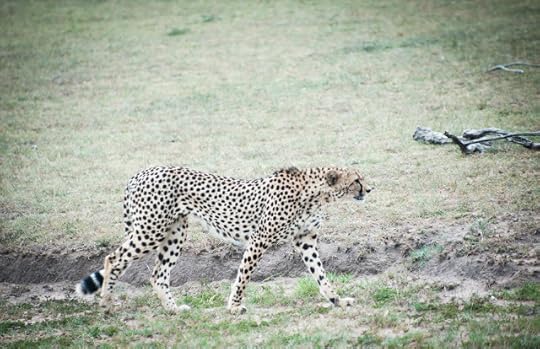 Yes, we did get to Masai Mara and saw this beautiful cheetah, but...
Yes, we did get to Masai Mara and saw this beautiful cheetah, but...
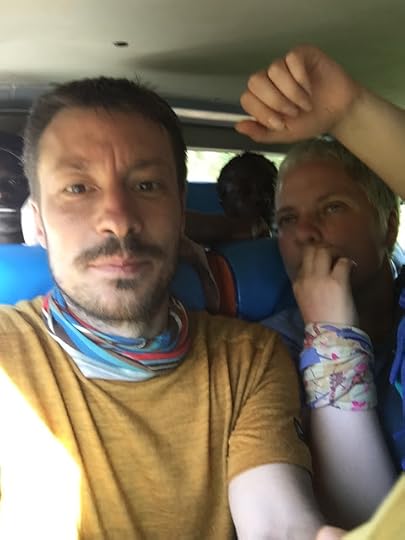 ...first we travelled for a whole day, mainly using matatus - which is not always fun -
...first we travelled for a whole day, mainly using matatus - which is not always fun -
Comments[image error] What’s with all those ‘You are both cute’ and ‘Let’s meet up someday’ that we often see as comments to our posts? The first reeks of pretence and the second is not going to happen, because you don’t actually mean it, do you?[image error] And what about trolls? I sometimes sit and wonder: ‘Don’t those people have anything else to do than bully innocent users?’.I guess not. See second bullet under Pictures. Psychic diseases are the new norm. Narcissists are ruling many countries, so why wouldn’t sociopaths and psychopaths be celebrated on social media? Maybe virtual statues should start being erected in their honour. Just sayin’.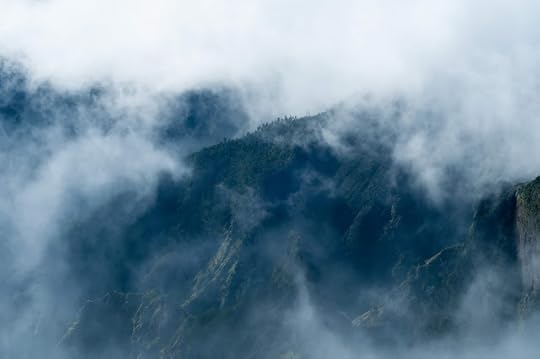 Trolls are a bit fuzzy about their motives, just like these clouds around Pico Ruivo, Madeira
Trolls are a bit fuzzy about their motives, just like these clouds around Pico Ruivo, Madeira
Private messages[image error] I work. Quite a lot. Actually, between 2007 and 2019, I barely had time to sleep. Plus, I have my close friends. If I got to chat every day for tens of minutes with the new people in my life or with those new followers on the several social media channels that I use, I wouldn’t really have time to do the other things in my life that need to be done.Yes, I always reply, but very few people understand that there’s a thin line between polite approach and stalking.Aaaaah, and whenever I see ‘my friend’ written down, it feels so fake, that my first impulse is not to continue my interaction with the author.[image error] One of the things that I always say is—beware of getting catfished. Tricked. Convinced to send money. Convinced that you are loved. Not all people have the morals that you do.Hold on to your heart, first and foremost. When you don’t actually know the person in flesh and blood, any online relationship [love, friendship, business] should be taken with a pinch of salt.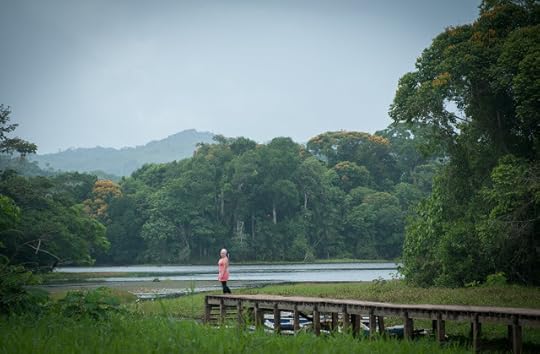 You are sometimes tricked to go somewhere, just like it happened to us in Panama
You are sometimes tricked to go somewhere, just like it happened to us in Panama
Followers[image error] When I started tweeting back in 2012, I was surprised to witness the Follow/Unfollow game. It slowed down on Twitter, but it’s even more aggressive on Instagram. Which I don’t like, I consider rude, and I would never do that to another account.It’s pretty sad if one’s entire existence is only validated by followers and likes, many times at the expense of hurting others.[image error] There are many fake people only buttering you up, to gain exposure.You’re not the only one being told how wonderful your feed is. [image error] We’ve all probably been there: a person we considered close [sometimes very close] blocking us all of a sudden and showing his/her true feelings towards us [good to know, btw], in a coup of narcissistic rage [there are fewer and fewer sane persons around us, just pay close attention and you’ll notice that]. Or, the funniest thing of all, they’ll unfollow you on Instagram, but stay friends with you on Facebook. For example. WTF?First of all, if we disagree on something, it doesn’t mean that I am your enemy. Secondly, if you bully me, I will break free at one point. Thirdly, if you don’t have the guts to say it to my face, there are some more elegant ways to go about: Mute (Twitter & Insta), Unfollow (FB), etc.This is how we realise that the person we helped and cared for had no respect for what we shared.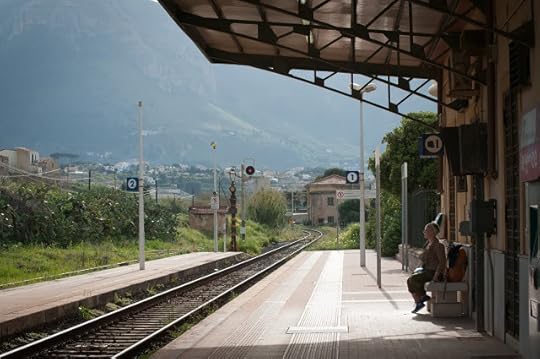 I, for one, want only positive things and peace | Somewhere in Sicily
I, for one, want only positive things and peace | Somewhere in Sicily
Communities[image error] Decent communities are rara avis. There’s only one social media channel where I found such a community and I am proud to be part of it. It’s Trover. There, people help each other with suggestions, encourage one another to discover places, and are genuine.From a traveller’s perspective, sadly, such honesty is hard to find. Most community members don’t know how to use you and discard you faster – a.k.a. make you follow them and then unfollow you.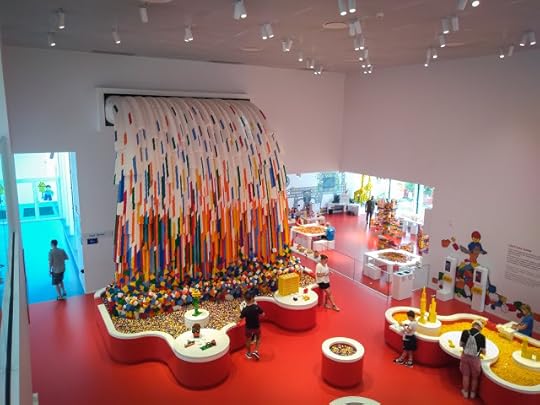 The rainbow stands tall; here, at LEGO House in Billund, Denmark
The rainbow stands tall; here, at LEGO House in Billund, Denmark
This is the exchange rate of our days, apparently.The funny thing is that I STILL BELIEVE. I still believe that there are people like me out there, with real values, who can and will CHANGE THE WORLD.
Pictures[image error] You will surely agree: pictures with children beat all other achievements.Why? Almost every person can have a child, but not all of us can ice climb.[image error] When somebody posts a picture in a place that’s familiar to many people and not really niche, there’s a whole bunch of thumbs up and hearts involved. Even though the nichepicture is ten times more beautiful or special, it will most surely remain in the shadows.People tend to validate themselves through others, so a picture of, say, Rome would surely be more popular than one of Tehran because more users have experienced it.
![Café scene in Tehran, Iran [taken from Instagram]](https://i.gr-assets.com/images/S/compressed.photo.goodreads.com/hostedimages/1567197666i/28076247._SY540_.jpg) Café scene in Tehran, Iran [taken from Instagram]
Café scene in Tehran, Iran [taken from Instagram]Posts[image error] Well, it doesn’t really matter whether you’ve climbed Everest, kayaked the Nile source-to-sea, or registered another achievement [that many others probably won’t ever experience during their life], if you get married – even if it’s to a partner who has not and is not going to make you happy, everybody’s congratulating and cheering you on. Am I right, Facebook users? Yup, people feel much better around other people who act exactly as they do than around people who are genuinely living their lives in a more interesting way than they do [see second bullet under Pictures]. [image error] Lies vs. reality. How many of you are your absolute selves on social media? Precisely. It’s a beautified world. I am probably close to 90-95% of the real me, but how many like me are there around? I know that my close friends are true, because I know who keeps me company over dinner. We start small – a Photoshopped picture, bragging about our activities in ____, and end up lying in a seriously lugubrious manner. Who wakes up every morning with roses on their night table? Which kitchen counter is ever perfectly neat after you’ve finished baking? A-ham. How many times do we lie and recommend places, products, services simply because we are emotionally attached to their providers or we’ve been paid to write a good review? [and that’s such a long and disappointing story nowadays…]
 Yes, we did get to Masai Mara and saw this beautiful cheetah, but...
Yes, we did get to Masai Mara and saw this beautiful cheetah, but...
 ...first we travelled for a whole day, mainly using matatus - which is not always fun -
...first we travelled for a whole day, mainly using matatus - which is not always fun -Comments[image error] What’s with all those ‘You are both cute’ and ‘Let’s meet up someday’ that we often see as comments to our posts? The first reeks of pretence and the second is not going to happen, because you don’t actually mean it, do you?[image error] And what about trolls? I sometimes sit and wonder: ‘Don’t those people have anything else to do than bully innocent users?’.I guess not. See second bullet under Pictures. Psychic diseases are the new norm. Narcissists are ruling many countries, so why wouldn’t sociopaths and psychopaths be celebrated on social media? Maybe virtual statues should start being erected in their honour. Just sayin’.
 Trolls are a bit fuzzy about their motives, just like these clouds around Pico Ruivo, Madeira
Trolls are a bit fuzzy about their motives, just like these clouds around Pico Ruivo, Madeira
Private messages[image error] I work. Quite a lot. Actually, between 2007 and 2019, I barely had time to sleep. Plus, I have my close friends. If I got to chat every day for tens of minutes with the new people in my life or with those new followers on the several social media channels that I use, I wouldn’t really have time to do the other things in my life that need to be done.Yes, I always reply, but very few people understand that there’s a thin line between polite approach and stalking.Aaaaah, and whenever I see ‘my friend’ written down, it feels so fake, that my first impulse is not to continue my interaction with the author.[image error] One of the things that I always say is—beware of getting catfished. Tricked. Convinced to send money. Convinced that you are loved. Not all people have the morals that you do.Hold on to your heart, first and foremost. When you don’t actually know the person in flesh and blood, any online relationship [love, friendship, business] should be taken with a pinch of salt.
 You are sometimes tricked to go somewhere, just like it happened to us in Panama
You are sometimes tricked to go somewhere, just like it happened to us in PanamaFollowers[image error] When I started tweeting back in 2012, I was surprised to witness the Follow/Unfollow game. It slowed down on Twitter, but it’s even more aggressive on Instagram. Which I don’t like, I consider rude, and I would never do that to another account.It’s pretty sad if one’s entire existence is only validated by followers and likes, many times at the expense of hurting others.[image error] There are many fake people only buttering you up, to gain exposure.You’re not the only one being told how wonderful your feed is. [image error] We’ve all probably been there: a person we considered close [sometimes very close] blocking us all of a sudden and showing his/her true feelings towards us [good to know, btw], in a coup of narcissistic rage [there are fewer and fewer sane persons around us, just pay close attention and you’ll notice that]. Or, the funniest thing of all, they’ll unfollow you on Instagram, but stay friends with you on Facebook. For example. WTF?First of all, if we disagree on something, it doesn’t mean that I am your enemy. Secondly, if you bully me, I will break free at one point. Thirdly, if you don’t have the guts to say it to my face, there are some more elegant ways to go about: Mute (Twitter & Insta), Unfollow (FB), etc.This is how we realise that the person we helped and cared for had no respect for what we shared.
 I, for one, want only positive things and peace | Somewhere in Sicily
I, for one, want only positive things and peace | Somewhere in SicilyCommunities[image error] Decent communities are rara avis. There’s only one social media channel where I found such a community and I am proud to be part of it. It’s Trover. There, people help each other with suggestions, encourage one another to discover places, and are genuine.From a traveller’s perspective, sadly, such honesty is hard to find. Most community members don’t know how to use you and discard you faster – a.k.a. make you follow them and then unfollow you.
 The rainbow stands tall; here, at LEGO House in Billund, Denmark
The rainbow stands tall; here, at LEGO House in Billund, Denmark
This is the exchange rate of our days, apparently.The funny thing is that I STILL BELIEVE. I still believe that there are people like me out there, with real values, who can and will CHANGE THE WORLD.
Published on August 29, 2019 13:37
August 22, 2019
De cealaltă parte a Deltei Dunării, în Ucraina
Visam de mult la ce se găsea de cealaltă parte a Dunării, la nord. La locul de care fusesem mereu atât de aproape! Mângâiam parcă harta cu ochii. Mi-am luat inima-n dinţi anul acesta şi am zis că ar trebui să fac ceva. Am scris Poliţiei de Frontieră. Şi, aşa cum mi se pare că multe lucruri se schimbă în ţară în BINE – dacă deschideţi ochii larg veţi vedea că aşa este –, m-au sunat. M-au sunat înainte de expirarea termenului legal în care puteau să îmi răspundă doar ca să aibă ocazia de a-mi furniza soluţia înainte de plecarea mea în călătorie. A fost un domn foarte politicos. Ce mi-a spus el? Că puteam face formalităţile de ieşire în Brăila, Galaţi sau Tulcea şi pe cele de intrare în Orlivka sau Izmail. Planul iniţial era să luăm caiacele şi să traversăm Dunărea, apoi să explorăm partea ucraineană. Totul urma să dureze sub o jumătate de oră, cu anunţarea în prealabil a oficiului de înregistrare. Vreun schepsis? Da, ni se recomanda să revenim în ţară în aceeaşi locaţie de unde plecaserăm.Am stat noi, am cântărit-o.Lui Marcel îi surâdea: „Ar fi fain să mai schimbăm traseul din Deltă, nu zic nu”.Timpul, însă, ne-a fost vrăjmaş.Ne resimţim amândoi. A fost un an greu, din toate punctele de vedere. Unul dintre cei mai grei. Cu toate acestea, nu ne-am lăsat şi nu ne vom lăsa.
Aşa că, mângâind în continuare harta cu ochii, mi-a venit o nouă idee – şi nu îmi venea să cred că nu mă gândisem la ea niciodată! O traversare terestră. Galaţi – Giurgiuleşti – Reni. Moldovenii au strâmbat din nas când au văzut cartea verde printată clasic (fără jumătatea verde, aşadar): „În Europa merge, dar aici...” Am dat peste aceeaşi replică în partea moldoveano-ucraineană (vamă comună, by the way). Unde mai pui că cei 1.6km parcurşi pe-un drum ce nu se putea numi drum prin Republica Moldova necesitau cumpărarea vignetei. Mda. Comandantul a vrut să ne dea „retur”, însă, până la urmă, după cum ne-am obişnuit la trecerile cu Ucraina, s-a rezolvat. Am urmat un drum extraordinar de bun şi de gol, cu vântul suflând puternic şi cu valuri mari pe Lacul Bolgrad. Acolo a sunat clopoţelul: cum istoria este una dintre marile mele pasiuni şi am urmat o pregătire în domeniu, mi-am amintit de „Cahul, Ismail şi Bolgrad”. Doar ce făcusem legătura! Cele trei judeţe controversate, plimbate prin graniţele mai multor state şi cedate Rusiei la sfârşitul lui 1878, apoi redobândite în 1918 prin unirea cu Basarabia şi pierdute din nou în Al Doilea Război Mondial. Fusese pământ românesc! De aceea îmi plăcea atât de mult! De aceea ne întrebaseră la graniţă dacă mergem la ospeţie!Orlivkăi i-a urmat un Izmail foarte curăţel şi îngrijit. Nu am putut zăbovi, fiind în mare întârziere, însă zâmbind la vederea aceloraşi culori folosite pentru decorarea caselor ca şi pe malul opus. Vylkove era plin de viaţă şi de oameni. Am urmat indicaţiile spre Pelican City (pe care-l vânasem de mult; 168 lei/căbănuţă triplă; 15 lei/persoană/mic dejun). Am fost întâmpinaţi de nisip şi de zâmbetul larg al unui domn care ne-a dus la căbănuţa noastră ce da-n spre râu. Nu înţelegeam prea multe din ceea ce ne spunea, dar intuiam. Colocatarii noştri erau pregătiţi – cu mâncare şi grătare. Era trecut de 21 şi restaurantul se închisese la 20. Cu toate acestea, au fost drăguţi să ne servească – adevărul este că eram lihniţi de foame. :-) Ne ajutase cu traducerea Dimitri, care vorbea binişor engleză.
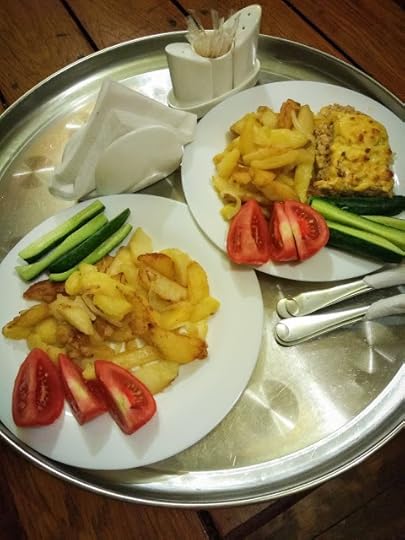 Am luat cina pe o băncuţă dotată cu o măsuţă, pe chiar malul apei, sub razele lunii. Eram fericită, ştiam că mă relaxasem total, la fel cum o făcusem la Teletskoye şi în Azore.
Am luat cina pe o băncuţă dotată cu o măsuţă, pe chiar malul apei, sub razele lunii. Eram fericită, ştiam că mă relaxasem total, la fel cum o făcusem la Teletskoye şi în Azore.
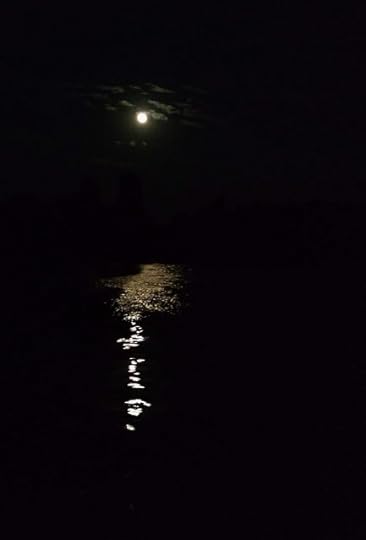 Micul dejun – clătite cu brânză dulce şi gogoşi – l-am luat într-un foişor de pe malul apei, din nou. Da, se gândiseră oamenii la toate. Cu checkout-ul la 12, aveam timp şi de o tură cu caiacul, chiar dacă era înnorat şi ploua uşor, când şi când. Începusem să îi înţeleg pe oamenii care făceau baie chiar dacă afară era destul de răcoare: apa era extrem de caldă!
Micul dejun – clătite cu brânză dulce şi gogoşi – l-am luat într-un foişor de pe malul apei, din nou. Da, se gândiseră oamenii la toate. Cu checkout-ul la 12, aveam timp şi de o tură cu caiacul, chiar dacă era înnorat şi ploua uşor, când şi când. Începusem să îi înţeleg pe oamenii care făceau baie chiar dacă afară era destul de răcoare: apa era extrem de caldă!
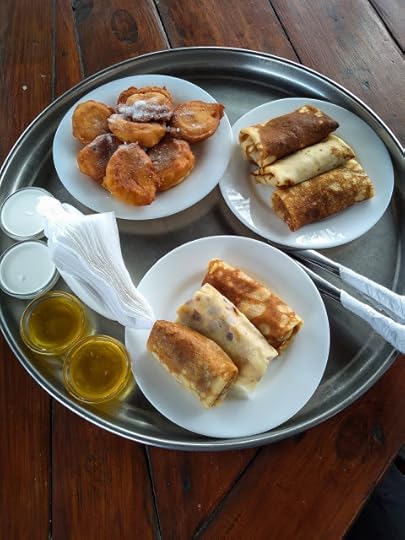 Pe râul Ochakivs'ke, ce comunica direct cu Braţul Chilia, apa umbla pe peste tot. Până la urmă, ne-am dumirit, am explorat canale mai mici, unde locuiau oameni (amintindu-mi de turul cu caiacele din Kerala), vâslind în cele din urmă pe un canal mai mare, unde am dat de bărci vechi şi de privelişti faine.
Pe râul Ochakivs'ke, ce comunica direct cu Braţul Chilia, apa umbla pe peste tot. Până la urmă, ne-am dumirit, am explorat canale mai mici, unde locuiau oameni (amintindu-mi de turul cu caiacele din Kerala), vâslind în cele din urmă pe un canal mai mare, unde am dat de bărci vechi şi de privelişti faine.
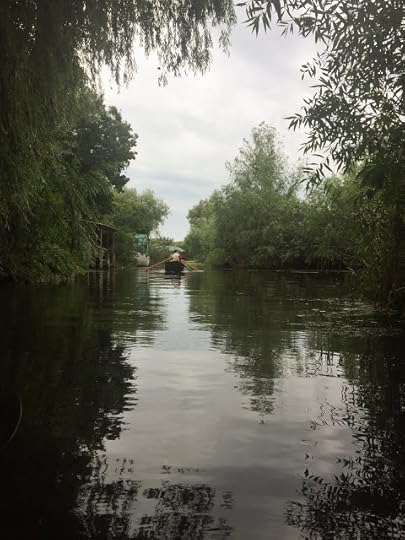
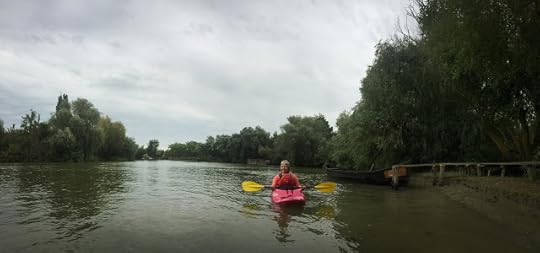 Am poposit pentru nişte cumpărături în Vylkove – din Ucraina nu putem pleca fără bomboane, sucuri şi votcă. De data asta, am luat şi lapte condensat, cum aveam şi noi pe vremuri. Este perfect pentru pregătirea deserturilor! Mai înainte însă, am poposit şi la Avtorsʹkyy Istoryko-Krayeznavchyy Muzey Khudozhnyka O. Sharonova. Am dat întâmplător peste el pe Instagram şi m-a fascinat prin multitudinea obiectelor de colecţie de pe când Vâlcovul era în România. I-am spus lui Marcel, le-am spus şi prietenilor: este unul dintre puţinele muzee în care-am fost şi nu am înţeles nimic... totuşi înţelegând atât de multe... La un moment dat, cu Gheorghe Zamfir pe fundal, în încăperea dedicată armelor, m-a bufnit un plâns... M-a mişcat, ne-a mişcat pe amândoi. Ne-am gândit la cât de drăguţi şi atenţi fuseseră oamenii cu noi, la cum nu aveau nimic cu noi şi nici noi cu ei... totuşi la cât de greu putuse să fie când forţe externe despărţiseră familii, case, visuri.
Am poposit pentru nişte cumpărături în Vylkove – din Ucraina nu putem pleca fără bomboane, sucuri şi votcă. De data asta, am luat şi lapte condensat, cum aveam şi noi pe vremuri. Este perfect pentru pregătirea deserturilor! Mai înainte însă, am poposit şi la Avtorsʹkyy Istoryko-Krayeznavchyy Muzey Khudozhnyka O. Sharonova. Am dat întâmplător peste el pe Instagram şi m-a fascinat prin multitudinea obiectelor de colecţie de pe când Vâlcovul era în România. I-am spus lui Marcel, le-am spus şi prietenilor: este unul dintre puţinele muzee în care-am fost şi nu am înţeles nimic... totuşi înţelegând atât de multe... La un moment dat, cu Gheorghe Zamfir pe fundal, în încăperea dedicată armelor, m-a bufnit un plâns... M-a mişcat, ne-a mişcat pe amândoi. Ne-am gândit la cât de drăguţi şi atenţi fuseseră oamenii cu noi, la cum nu aveau nimic cu noi şi nici noi cu ei... totuşi la cât de greu putuse să fie când forţe externe despărţiseră familii, case, visuri.
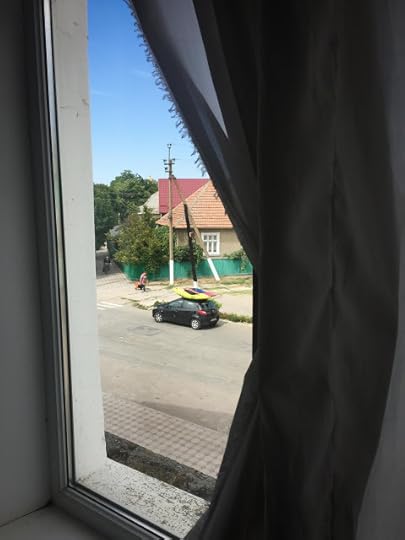
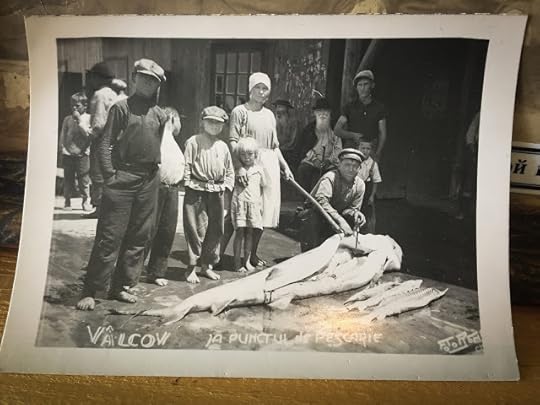
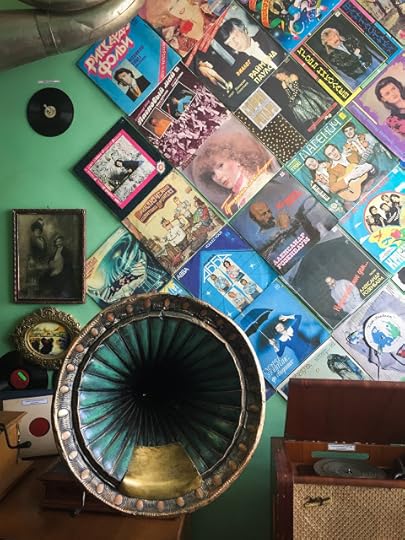 Dacă tot eram la doar 18 minute de mare, am zis să profităm (mai ales că Marcel nu a făcut nicio baie în mare în vara asta). Am purces înspre Prymors'ke. Am regăsit o atmosferă pe care-o lăsasem în urmă. Un vibe din copilăria mea, de la mare de la noi. Într-un punct, am văzut o plajă întinsă în dreapta noastră. Ne-am schimbat – chiar vreau să vă recomand un articol vestimentar pe care mi-aş fi dorit să îl inventez eu dacă nu ar fi fost inventat; este indispensabil tuturor practicanţilor de sporturi acvatice – şi, suprinşi de faptul că plaja părea destul de sălbatică (un fel de Corbu în varianta lor) şi destul de goală, ne-am pus prosopelul, ne-am aplicat crema de protecţie şi... ţuşti în apă! Mai întâi eu. Marcel a spus că era cam rece şi i-am dat dreptate. A mers bine însă o baie şi s-a dus şi el cu masca să se uite după peşti apoi. Cât timp eu am studiat pescăruşii extrem de prietenoşi din jurul prosoapelor.
Dacă tot eram la doar 18 minute de mare, am zis să profităm (mai ales că Marcel nu a făcut nicio baie în mare în vara asta). Am purces înspre Prymors'ke. Am regăsit o atmosferă pe care-o lăsasem în urmă. Un vibe din copilăria mea, de la mare de la noi. Într-un punct, am văzut o plajă întinsă în dreapta noastră. Ne-am schimbat – chiar vreau să vă recomand un articol vestimentar pe care mi-aş fi dorit să îl inventez eu dacă nu ar fi fost inventat; este indispensabil tuturor practicanţilor de sporturi acvatice – şi, suprinşi de faptul că plaja părea destul de sălbatică (un fel de Corbu în varianta lor) şi destul de goală, ne-am pus prosopelul, ne-am aplicat crema de protecţie şi... ţuşti în apă! Mai întâi eu. Marcel a spus că era cam rece şi i-am dat dreptate. A mers bine însă o baie şi s-a dus şi el cu masca să se uite după peşti apoi. Cât timp eu am studiat pescăruşii extrem de prietenoşi din jurul prosoapelor.
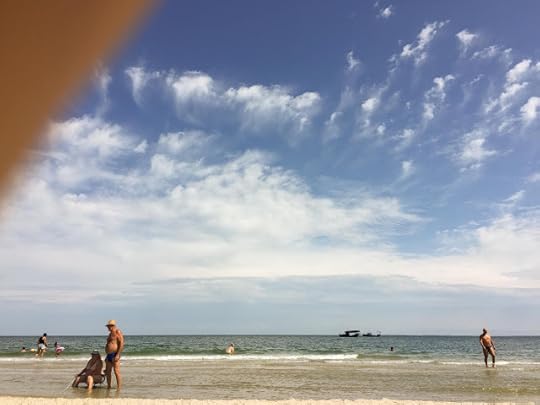 Fericiţi că apa nu fusese într-atât de sărată şi că ne puteam continua drumul spre Izmail fără niciun disconfort, cam asta am şi făcut. Ne aştepta Parmezan, un restaurant pe care pusesem ochii – citesc mult, voi ştiţi – încă de acasă. Şi nu am dat greş. Personal foarte amabil, design deosebit – ne-am ocupat imediat locurile în „ouăle” gigant –, preţuri bune şi... mâncarea, ah mâncarea! Nişte ravioli cum de mult nu am mai servit, o limonadă de mango uriaşă şi... una dintre cele mai bune prăjituri din viaţa mea. Ştiam de mult că, în vremurile apuse, în toate ţările Uniunii fusese tradiţie în coacerea acestei prăjituri (varianta adaptată a mille-feuille-ului) şi mai încercasem nişte variante strălucite prin Rusia. Ta-dah:Napoleon. Mamă, ce bun a fost!... Şi acum îmi plouă-n gură.
Fericiţi că apa nu fusese într-atât de sărată şi că ne puteam continua drumul spre Izmail fără niciun disconfort, cam asta am şi făcut. Ne aştepta Parmezan, un restaurant pe care pusesem ochii – citesc mult, voi ştiţi – încă de acasă. Şi nu am dat greş. Personal foarte amabil, design deosebit – ne-am ocupat imediat locurile în „ouăle” gigant –, preţuri bune şi... mâncarea, ah mâncarea! Nişte ravioli cum de mult nu am mai servit, o limonadă de mango uriaşă şi... una dintre cele mai bune prăjituri din viaţa mea. Ştiam de mult că, în vremurile apuse, în toate ţările Uniunii fusese tradiţie în coacerea acestei prăjituri (varianta adaptată a mille-feuille-ului) şi mai încercasem nişte variante strălucite prin Rusia. Ta-dah:Napoleon. Mamă, ce bun a fost!... Şi acum îmi plouă-n gură.
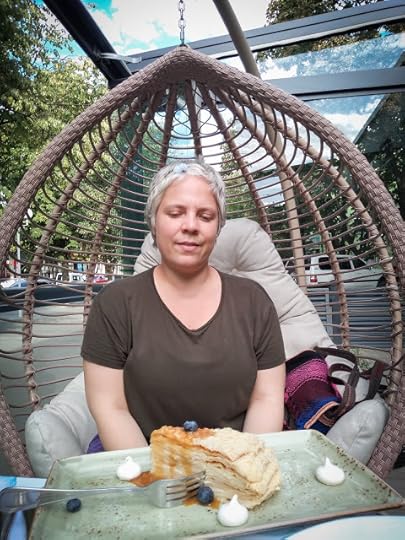 Am trecut încă o dată pe lângă Lacul Bolgrad – ce ne uimise cu o zi înainte – şi a urmat drumul spre graniţă, cu veselie şi jocuri prin maşină... şi am văzut şi o mare parte din Reni (că aşa ne-a dus GPS-ul).
Am trecut încă o dată pe lângă Lacul Bolgrad – ce ne uimise cu o zi înainte – şi a urmat drumul spre graniţă, cu veselie şi jocuri prin maşină... şi am văzut şi o mare parte din Reni (că aşa ne-a dus GPS-ul).
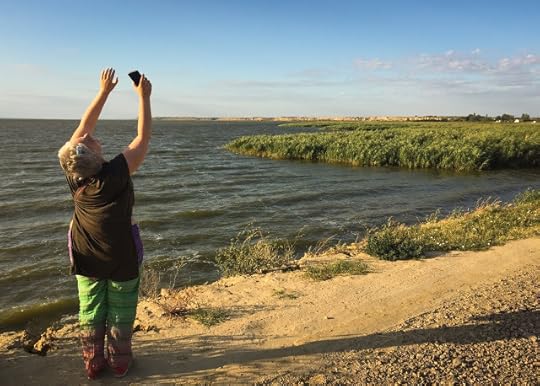 Am ştiut să ne facem vigneta de această dată, selectând manual reţeaua noastră şi plătind online, la sfatul unor domni români care aveau nişte discuţii cu vameşii ucraineni legate de nişte banale medicamente. Deşi puţine maşini, iarăşi a durat mult. Dar a trecut. Şi a fost fain!
Am ştiut să ne facem vigneta de această dată, selectând manual reţeaua noastră şi plătind online, la sfatul unor domni români care aveau nişte discuţii cu vameşii ucraineni legate de nişte banale medicamente. Deşi puţine maşini, iarăşi a durat mult. Dar a trecut. Şi a fost fain!
Aşa că, mângâind în continuare harta cu ochii, mi-a venit o nouă idee – şi nu îmi venea să cred că nu mă gândisem la ea niciodată! O traversare terestră. Galaţi – Giurgiuleşti – Reni. Moldovenii au strâmbat din nas când au văzut cartea verde printată clasic (fără jumătatea verde, aşadar): „În Europa merge, dar aici...” Am dat peste aceeaşi replică în partea moldoveano-ucraineană (vamă comună, by the way). Unde mai pui că cei 1.6km parcurşi pe-un drum ce nu se putea numi drum prin Republica Moldova necesitau cumpărarea vignetei. Mda. Comandantul a vrut să ne dea „retur”, însă, până la urmă, după cum ne-am obişnuit la trecerile cu Ucraina, s-a rezolvat. Am urmat un drum extraordinar de bun şi de gol, cu vântul suflând puternic şi cu valuri mari pe Lacul Bolgrad. Acolo a sunat clopoţelul: cum istoria este una dintre marile mele pasiuni şi am urmat o pregătire în domeniu, mi-am amintit de „Cahul, Ismail şi Bolgrad”. Doar ce făcusem legătura! Cele trei judeţe controversate, plimbate prin graniţele mai multor state şi cedate Rusiei la sfârşitul lui 1878, apoi redobândite în 1918 prin unirea cu Basarabia şi pierdute din nou în Al Doilea Război Mondial. Fusese pământ românesc! De aceea îmi plăcea atât de mult! De aceea ne întrebaseră la graniţă dacă mergem la ospeţie!Orlivkăi i-a urmat un Izmail foarte curăţel şi îngrijit. Nu am putut zăbovi, fiind în mare întârziere, însă zâmbind la vederea aceloraşi culori folosite pentru decorarea caselor ca şi pe malul opus. Vylkove era plin de viaţă şi de oameni. Am urmat indicaţiile spre Pelican City (pe care-l vânasem de mult; 168 lei/căbănuţă triplă; 15 lei/persoană/mic dejun). Am fost întâmpinaţi de nisip şi de zâmbetul larg al unui domn care ne-a dus la căbănuţa noastră ce da-n spre râu. Nu înţelegeam prea multe din ceea ce ne spunea, dar intuiam. Colocatarii noştri erau pregătiţi – cu mâncare şi grătare. Era trecut de 21 şi restaurantul se închisese la 20. Cu toate acestea, au fost drăguţi să ne servească – adevărul este că eram lihniţi de foame. :-) Ne ajutase cu traducerea Dimitri, care vorbea binişor engleză.
 Am luat cina pe o băncuţă dotată cu o măsuţă, pe chiar malul apei, sub razele lunii. Eram fericită, ştiam că mă relaxasem total, la fel cum o făcusem la Teletskoye şi în Azore.
Am luat cina pe o băncuţă dotată cu o măsuţă, pe chiar malul apei, sub razele lunii. Eram fericită, ştiam că mă relaxasem total, la fel cum o făcusem la Teletskoye şi în Azore.  Micul dejun – clătite cu brânză dulce şi gogoşi – l-am luat într-un foişor de pe malul apei, din nou. Da, se gândiseră oamenii la toate. Cu checkout-ul la 12, aveam timp şi de o tură cu caiacul, chiar dacă era înnorat şi ploua uşor, când şi când. Începusem să îi înţeleg pe oamenii care făceau baie chiar dacă afară era destul de răcoare: apa era extrem de caldă!
Micul dejun – clătite cu brânză dulce şi gogoşi – l-am luat într-un foişor de pe malul apei, din nou. Da, se gândiseră oamenii la toate. Cu checkout-ul la 12, aveam timp şi de o tură cu caiacul, chiar dacă era înnorat şi ploua uşor, când şi când. Începusem să îi înţeleg pe oamenii care făceau baie chiar dacă afară era destul de răcoare: apa era extrem de caldă!  Pe râul Ochakivs'ke, ce comunica direct cu Braţul Chilia, apa umbla pe peste tot. Până la urmă, ne-am dumirit, am explorat canale mai mici, unde locuiau oameni (amintindu-mi de turul cu caiacele din Kerala), vâslind în cele din urmă pe un canal mai mare, unde am dat de bărci vechi şi de privelişti faine.
Pe râul Ochakivs'ke, ce comunica direct cu Braţul Chilia, apa umbla pe peste tot. Până la urmă, ne-am dumirit, am explorat canale mai mici, unde locuiau oameni (amintindu-mi de turul cu caiacele din Kerala), vâslind în cele din urmă pe un canal mai mare, unde am dat de bărci vechi şi de privelişti faine.
 Am poposit pentru nişte cumpărături în Vylkove – din Ucraina nu putem pleca fără bomboane, sucuri şi votcă. De data asta, am luat şi lapte condensat, cum aveam şi noi pe vremuri. Este perfect pentru pregătirea deserturilor! Mai înainte însă, am poposit şi la Avtorsʹkyy Istoryko-Krayeznavchyy Muzey Khudozhnyka O. Sharonova. Am dat întâmplător peste el pe Instagram şi m-a fascinat prin multitudinea obiectelor de colecţie de pe când Vâlcovul era în România. I-am spus lui Marcel, le-am spus şi prietenilor: este unul dintre puţinele muzee în care-am fost şi nu am înţeles nimic... totuşi înţelegând atât de multe... La un moment dat, cu Gheorghe Zamfir pe fundal, în încăperea dedicată armelor, m-a bufnit un plâns... M-a mişcat, ne-a mişcat pe amândoi. Ne-am gândit la cât de drăguţi şi atenţi fuseseră oamenii cu noi, la cum nu aveau nimic cu noi şi nici noi cu ei... totuşi la cât de greu putuse să fie când forţe externe despărţiseră familii, case, visuri.
Am poposit pentru nişte cumpărături în Vylkove – din Ucraina nu putem pleca fără bomboane, sucuri şi votcă. De data asta, am luat şi lapte condensat, cum aveam şi noi pe vremuri. Este perfect pentru pregătirea deserturilor! Mai înainte însă, am poposit şi la Avtorsʹkyy Istoryko-Krayeznavchyy Muzey Khudozhnyka O. Sharonova. Am dat întâmplător peste el pe Instagram şi m-a fascinat prin multitudinea obiectelor de colecţie de pe când Vâlcovul era în România. I-am spus lui Marcel, le-am spus şi prietenilor: este unul dintre puţinele muzee în care-am fost şi nu am înţeles nimic... totuşi înţelegând atât de multe... La un moment dat, cu Gheorghe Zamfir pe fundal, în încăperea dedicată armelor, m-a bufnit un plâns... M-a mişcat, ne-a mişcat pe amândoi. Ne-am gândit la cât de drăguţi şi atenţi fuseseră oamenii cu noi, la cum nu aveau nimic cu noi şi nici noi cu ei... totuşi la cât de greu putuse să fie când forţe externe despărţiseră familii, case, visuri. 

 Dacă tot eram la doar 18 minute de mare, am zis să profităm (mai ales că Marcel nu a făcut nicio baie în mare în vara asta). Am purces înspre Prymors'ke. Am regăsit o atmosferă pe care-o lăsasem în urmă. Un vibe din copilăria mea, de la mare de la noi. Într-un punct, am văzut o plajă întinsă în dreapta noastră. Ne-am schimbat – chiar vreau să vă recomand un articol vestimentar pe care mi-aş fi dorit să îl inventez eu dacă nu ar fi fost inventat; este indispensabil tuturor practicanţilor de sporturi acvatice – şi, suprinşi de faptul că plaja părea destul de sălbatică (un fel de Corbu în varianta lor) şi destul de goală, ne-am pus prosopelul, ne-am aplicat crema de protecţie şi... ţuşti în apă! Mai întâi eu. Marcel a spus că era cam rece şi i-am dat dreptate. A mers bine însă o baie şi s-a dus şi el cu masca să se uite după peşti apoi. Cât timp eu am studiat pescăruşii extrem de prietenoşi din jurul prosoapelor.
Dacă tot eram la doar 18 minute de mare, am zis să profităm (mai ales că Marcel nu a făcut nicio baie în mare în vara asta). Am purces înspre Prymors'ke. Am regăsit o atmosferă pe care-o lăsasem în urmă. Un vibe din copilăria mea, de la mare de la noi. Într-un punct, am văzut o plajă întinsă în dreapta noastră. Ne-am schimbat – chiar vreau să vă recomand un articol vestimentar pe care mi-aş fi dorit să îl inventez eu dacă nu ar fi fost inventat; este indispensabil tuturor practicanţilor de sporturi acvatice – şi, suprinşi de faptul că plaja părea destul de sălbatică (un fel de Corbu în varianta lor) şi destul de goală, ne-am pus prosopelul, ne-am aplicat crema de protecţie şi... ţuşti în apă! Mai întâi eu. Marcel a spus că era cam rece şi i-am dat dreptate. A mers bine însă o baie şi s-a dus şi el cu masca să se uite după peşti apoi. Cât timp eu am studiat pescăruşii extrem de prietenoşi din jurul prosoapelor. Fericiţi că apa nu fusese într-atât de sărată şi că ne puteam continua drumul spre Izmail fără niciun disconfort, cam asta am şi făcut. Ne aştepta Parmezan, un restaurant pe care pusesem ochii – citesc mult, voi ştiţi – încă de acasă. Şi nu am dat greş. Personal foarte amabil, design deosebit – ne-am ocupat imediat locurile în „ouăle” gigant –, preţuri bune şi... mâncarea, ah mâncarea! Nişte ravioli cum de mult nu am mai servit, o limonadă de mango uriaşă şi... una dintre cele mai bune prăjituri din viaţa mea. Ştiam de mult că, în vremurile apuse, în toate ţările Uniunii fusese tradiţie în coacerea acestei prăjituri (varianta adaptată a mille-feuille-ului) şi mai încercasem nişte variante strălucite prin Rusia. Ta-dah:Napoleon. Mamă, ce bun a fost!... Şi acum îmi plouă-n gură.
Fericiţi că apa nu fusese într-atât de sărată şi că ne puteam continua drumul spre Izmail fără niciun disconfort, cam asta am şi făcut. Ne aştepta Parmezan, un restaurant pe care pusesem ochii – citesc mult, voi ştiţi – încă de acasă. Şi nu am dat greş. Personal foarte amabil, design deosebit – ne-am ocupat imediat locurile în „ouăle” gigant –, preţuri bune şi... mâncarea, ah mâncarea! Nişte ravioli cum de mult nu am mai servit, o limonadă de mango uriaşă şi... una dintre cele mai bune prăjituri din viaţa mea. Ştiam de mult că, în vremurile apuse, în toate ţările Uniunii fusese tradiţie în coacerea acestei prăjituri (varianta adaptată a mille-feuille-ului) şi mai încercasem nişte variante strălucite prin Rusia. Ta-dah:Napoleon. Mamă, ce bun a fost!... Şi acum îmi plouă-n gură. Am trecut încă o dată pe lângă Lacul Bolgrad – ce ne uimise cu o zi înainte – şi a urmat drumul spre graniţă, cu veselie şi jocuri prin maşină... şi am văzut şi o mare parte din Reni (că aşa ne-a dus GPS-ul).
Am trecut încă o dată pe lângă Lacul Bolgrad – ce ne uimise cu o zi înainte – şi a urmat drumul spre graniţă, cu veselie şi jocuri prin maşină... şi am văzut şi o mare parte din Reni (că aşa ne-a dus GPS-ul). Am ştiut să ne facem vigneta de această dată, selectând manual reţeaua noastră şi plătind online, la sfatul unor domni români care aveau nişte discuţii cu vameşii ucraineni legate de nişte banale medicamente. Deşi puţine maşini, iarăşi a durat mult. Dar a trecut. Şi a fost fain!
Am ştiut să ne facem vigneta de această dată, selectând manual reţeaua noastră şi plătind online, la sfatul unor domni români care aveau nişte discuţii cu vameşii ucraineni legate de nişte banale medicamente. Deşi puţine maşini, iarăşi a durat mult. Dar a trecut. Şi a fost fain!
Published on August 22, 2019 13:51
August 8, 2019
Gilan’s Rudkhan Castle and Masuleh
Throughout Iran, whenever I mentioned Gilan and the fact that I loved the food there most, locals would laugh it off—‘They’re vegetarian in Gilan’ :-). My point precisely.Having left Mazandaran’s Ramsar in a mix of terrible heat and humidity, we continued in the same way along the rice fields of Gilan Province. The oranges and the blood oranges that Marcel bought on the side of the road helped us stay hydrated.
 We had changed our route and were aiming for Rudkhan Castle and then… spending the night in Masuleh. We didn’t know that it would be a bit tricky, time-wise. [Drivingthrough the north of Iran turned out to be the most challenging from all the countries in the world we’d seen and it took a lot of time getting from point A to point B unharmed. Marcel will always be my hero.]Fast-forward a bit—we were standing in the giant parking and… it was full. No foreigners, no guides, only locals. Many of them were cheerfully shopping for food and various items made in the area and they were all looking at us curiously. I needed to check the date – no, it wasn’t one of their weekly days off. It was a day like all other days.
We had changed our route and were aiming for Rudkhan Castle and then… spending the night in Masuleh. We didn’t know that it would be a bit tricky, time-wise. [Drivingthrough the north of Iran turned out to be the most challenging from all the countries in the world we’d seen and it took a lot of time getting from point A to point B unharmed. Marcel will always be my hero.]Fast-forward a bit—we were standing in the giant parking and… it was full. No foreigners, no guides, only locals. Many of them were cheerfully shopping for food and various items made in the area and they were all looking at us curiously. I needed to check the date – no, it wasn’t one of their weekly days off. It was a day like all other days.
 By the time we had started to climb the steps to Rudkhan, we had already replied to tens of ‘Welcome’s and ‘Where are you from?’s. We had already taken selfies. We had already been part of live streams that were shot ‘without us knowing’. I didn’t mind. I was happy to be part of their joy and positivism, of the Iran that never leaves one disappointed. I was also looking curiously at the people picnicking along the trail or close to the water.
By the time we had started to climb the steps to Rudkhan, we had already replied to tens of ‘Welcome’s and ‘Where are you from?’s. We had already taken selfies. We had already been part of live streams that were shot ‘without us knowing’. I didn’t mind. I was happy to be part of their joy and positivism, of the Iran that never leaves one disappointed. I was also looking curiously at the people picnicking along the trail or close to the water.
 I wasn’t used to the tremendous heat or to wearing the hijab and I didn’t quite understand the use of the steps [as they were too high for me and for the children heading to the castle, too], so I took the ‘off-piste’ climbing route whenever possible. I was hyperventilating and dying to wear short sleeves. Still, we were encouraged to move on and told how far or close we were; in the end, we reached the ruins.
I wasn’t used to the tremendous heat or to wearing the hijab and I didn’t quite understand the use of the steps [as they were too high for me and for the children heading to the castle, too], so I took the ‘off-piste’ climbing route whenever possible. I was hyperventilating and dying to wear short sleeves. Still, we were encouraged to move on and told how far or close we were; in the end, we reached the ruins.
 Rudkhan Castle – a medieval fortress built as a form of protection against Arab attacks. And more steps to climb. I found my haven in a corner overlooking a sea of green. Ehsan, a young man speaking excellent English and originally from Arak, came over for a small chat; I also met his wife and he then called my data operator and helped me with precious information on how to recharge my card. While we were exchanging contact details, he saw ‘Botic’ as one of the last numbers I’d called. I explained that it was Marcel’s and he met him a few minutes later. On our way down, I stumbled upon Asma. Originally from Kermanshah, she was also travelling the north. She asked for my Instagram account and we connected immediately, as she is very kind and full of positive energy.I am still friends with both of them and we keep in touch. I am grateful that the trip to Rudkhan Castle helped me meet them!Nearly at the base of the route, a funny thing happened.‘Where are you from?’ we were again asked at one point.‘C’mon’ another guy cut in ‘It’s Botic and his wife and they’re from Romania.’Shock. And laughter. Marcel was now officially the ‘king of Rudkhan’, as I started to tease him. The smiles didn’t stop as we found our way back to the parking, buying water, jam jelly, local bakes, and even a small green clay pot for me [I now use it to store salt and I haven’t seen similar items in other parts of Iran; so, if you like something, buy it – you could also help the community this way].
Rudkhan Castle – a medieval fortress built as a form of protection against Arab attacks. And more steps to climb. I found my haven in a corner overlooking a sea of green. Ehsan, a young man speaking excellent English and originally from Arak, came over for a small chat; I also met his wife and he then called my data operator and helped me with precious information on how to recharge my card. While we were exchanging contact details, he saw ‘Botic’ as one of the last numbers I’d called. I explained that it was Marcel’s and he met him a few minutes later. On our way down, I stumbled upon Asma. Originally from Kermanshah, she was also travelling the north. She asked for my Instagram account and we connected immediately, as she is very kind and full of positive energy.I am still friends with both of them and we keep in touch. I am grateful that the trip to Rudkhan Castle helped me meet them!Nearly at the base of the route, a funny thing happened.‘Where are you from?’ we were again asked at one point.‘C’mon’ another guy cut in ‘It’s Botic and his wife and they’re from Romania.’Shock. And laughter. Marcel was now officially the ‘king of Rudkhan’, as I started to tease him. The smiles didn’t stop as we found our way back to the parking, buying water, jam jelly, local bakes, and even a small green clay pot for me [I now use it to store salt and I haven’t seen similar items in other parts of Iran; so, if you like something, buy it – you could also help the community this way].
Past the rice fields, we had no idea how we would find a place to stay in Masuleh Village and we were struggling to make it there right before it started getting dark, to perceive the contrast between the lit windows and the sky.It almost happened, as the guys waiting (with accommodation offers) right after the checkpoint didn’t understand that we needed a roof but were keen on taking pictures first… We returned to them, after a first set of shots. The sides of the road were packed with cars and I honestly couldn’t climb anymore, not after Rudkhan. I was cold and I was shivering, so Marcel went to have a look. He returned with good news: the house was modest, but it had a shower, and you couldn’t quite beat the EUR 12 price tag. He helped the guys vacuum and get the house ready for us while I fell in love with the view, agreeing to those who’ve said that Masuleh is one of the most beautiful villages in the world.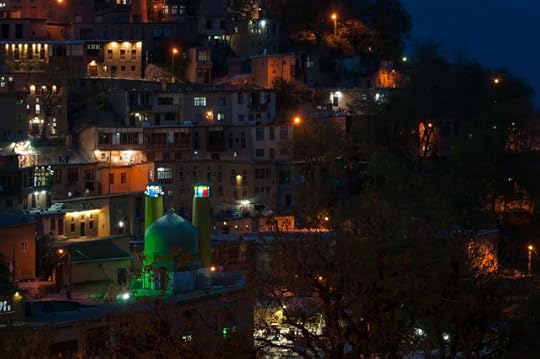 Terraced. Friendly. Full of buzz in its small centre. It’s where we had our dinner, not being able to locate the restaurant of our host’s brother. I had heard a lot of good things about Mirza Ghasemi (=a mix of eggplant, tomatoes, and garlic), but I had no idea that I would like it that much! I actually congratulated the chef and asked for a second portion. The delicate yet poignant flavours of the main ingredients would stay with me throughout our Iranian trip and would be my solution to not going to bed on an empty stomach on most of my North-Iranian nights.We weren’t able to sleep much, didn’t particularly enjoy breakfast, but loved walking the various levels of the village the following morning. Called by notes of cinnamon, I discovered a local bakery. They gifted me sesame treats and I ended up taking away a big piece of the cake they’d just taken out of the oven.
Terraced. Friendly. Full of buzz in its small centre. It’s where we had our dinner, not being able to locate the restaurant of our host’s brother. I had heard a lot of good things about Mirza Ghasemi (=a mix of eggplant, tomatoes, and garlic), but I had no idea that I would like it that much! I actually congratulated the chef and asked for a second portion. The delicate yet poignant flavours of the main ingredients would stay with me throughout our Iranian trip and would be my solution to not going to bed on an empty stomach on most of my North-Iranian nights.We weren’t able to sleep much, didn’t particularly enjoy breakfast, but loved walking the various levels of the village the following morning. Called by notes of cinnamon, I discovered a local bakery. They gifted me sesame treats and I ended up taking away a big piece of the cake they’d just taken out of the oven.


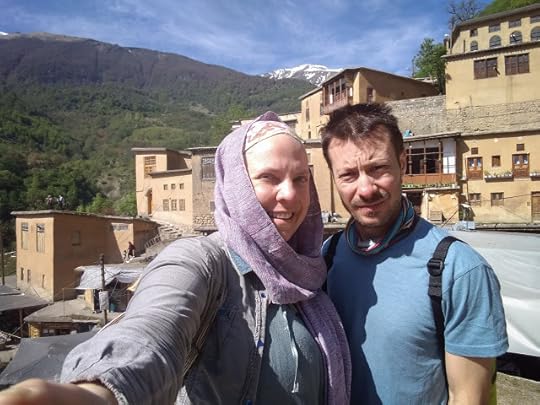

There was another road ahead, another province waiting, and a good deal of adventures along the way! A confession for the end – I now climb stairs very easily. :D
 We had changed our route and were aiming for Rudkhan Castle and then… spending the night in Masuleh. We didn’t know that it would be a bit tricky, time-wise. [Drivingthrough the north of Iran turned out to be the most challenging from all the countries in the world we’d seen and it took a lot of time getting from point A to point B unharmed. Marcel will always be my hero.]Fast-forward a bit—we were standing in the giant parking and… it was full. No foreigners, no guides, only locals. Many of them were cheerfully shopping for food and various items made in the area and they were all looking at us curiously. I needed to check the date – no, it wasn’t one of their weekly days off. It was a day like all other days.
We had changed our route and were aiming for Rudkhan Castle and then… spending the night in Masuleh. We didn’t know that it would be a bit tricky, time-wise. [Drivingthrough the north of Iran turned out to be the most challenging from all the countries in the world we’d seen and it took a lot of time getting from point A to point B unharmed. Marcel will always be my hero.]Fast-forward a bit—we were standing in the giant parking and… it was full. No foreigners, no guides, only locals. Many of them were cheerfully shopping for food and various items made in the area and they were all looking at us curiously. I needed to check the date – no, it wasn’t one of their weekly days off. It was a day like all other days.
 By the time we had started to climb the steps to Rudkhan, we had already replied to tens of ‘Welcome’s and ‘Where are you from?’s. We had already taken selfies. We had already been part of live streams that were shot ‘without us knowing’. I didn’t mind. I was happy to be part of their joy and positivism, of the Iran that never leaves one disappointed. I was also looking curiously at the people picnicking along the trail or close to the water.
By the time we had started to climb the steps to Rudkhan, we had already replied to tens of ‘Welcome’s and ‘Where are you from?’s. We had already taken selfies. We had already been part of live streams that were shot ‘without us knowing’. I didn’t mind. I was happy to be part of their joy and positivism, of the Iran that never leaves one disappointed. I was also looking curiously at the people picnicking along the trail or close to the water.
 I wasn’t used to the tremendous heat or to wearing the hijab and I didn’t quite understand the use of the steps [as they were too high for me and for the children heading to the castle, too], so I took the ‘off-piste’ climbing route whenever possible. I was hyperventilating and dying to wear short sleeves. Still, we were encouraged to move on and told how far or close we were; in the end, we reached the ruins.
I wasn’t used to the tremendous heat or to wearing the hijab and I didn’t quite understand the use of the steps [as they were too high for me and for the children heading to the castle, too], so I took the ‘off-piste’ climbing route whenever possible. I was hyperventilating and dying to wear short sleeves. Still, we were encouraged to move on and told how far or close we were; in the end, we reached the ruins.
 Rudkhan Castle – a medieval fortress built as a form of protection against Arab attacks. And more steps to climb. I found my haven in a corner overlooking a sea of green. Ehsan, a young man speaking excellent English and originally from Arak, came over for a small chat; I also met his wife and he then called my data operator and helped me with precious information on how to recharge my card. While we were exchanging contact details, he saw ‘Botic’ as one of the last numbers I’d called. I explained that it was Marcel’s and he met him a few minutes later. On our way down, I stumbled upon Asma. Originally from Kermanshah, she was also travelling the north. She asked for my Instagram account and we connected immediately, as she is very kind and full of positive energy.I am still friends with both of them and we keep in touch. I am grateful that the trip to Rudkhan Castle helped me meet them!Nearly at the base of the route, a funny thing happened.‘Where are you from?’ we were again asked at one point.‘C’mon’ another guy cut in ‘It’s Botic and his wife and they’re from Romania.’Shock. And laughter. Marcel was now officially the ‘king of Rudkhan’, as I started to tease him. The smiles didn’t stop as we found our way back to the parking, buying water, jam jelly, local bakes, and even a small green clay pot for me [I now use it to store salt and I haven’t seen similar items in other parts of Iran; so, if you like something, buy it – you could also help the community this way].
Rudkhan Castle – a medieval fortress built as a form of protection against Arab attacks. And more steps to climb. I found my haven in a corner overlooking a sea of green. Ehsan, a young man speaking excellent English and originally from Arak, came over for a small chat; I also met his wife and he then called my data operator and helped me with precious information on how to recharge my card. While we were exchanging contact details, he saw ‘Botic’ as one of the last numbers I’d called. I explained that it was Marcel’s and he met him a few minutes later. On our way down, I stumbled upon Asma. Originally from Kermanshah, she was also travelling the north. She asked for my Instagram account and we connected immediately, as she is very kind and full of positive energy.I am still friends with both of them and we keep in touch. I am grateful that the trip to Rudkhan Castle helped me meet them!Nearly at the base of the route, a funny thing happened.‘Where are you from?’ we were again asked at one point.‘C’mon’ another guy cut in ‘It’s Botic and his wife and they’re from Romania.’Shock. And laughter. Marcel was now officially the ‘king of Rudkhan’, as I started to tease him. The smiles didn’t stop as we found our way back to the parking, buying water, jam jelly, local bakes, and even a small green clay pot for me [I now use it to store salt and I haven’t seen similar items in other parts of Iran; so, if you like something, buy it – you could also help the community this way]. Past the rice fields, we had no idea how we would find a place to stay in Masuleh Village and we were struggling to make it there right before it started getting dark, to perceive the contrast between the lit windows and the sky.It almost happened, as the guys waiting (with accommodation offers) right after the checkpoint didn’t understand that we needed a roof but were keen on taking pictures first… We returned to them, after a first set of shots. The sides of the road were packed with cars and I honestly couldn’t climb anymore, not after Rudkhan. I was cold and I was shivering, so Marcel went to have a look. He returned with good news: the house was modest, but it had a shower, and you couldn’t quite beat the EUR 12 price tag. He helped the guys vacuum and get the house ready for us while I fell in love with the view, agreeing to those who’ve said that Masuleh is one of the most beautiful villages in the world.
 Terraced. Friendly. Full of buzz in its small centre. It’s where we had our dinner, not being able to locate the restaurant of our host’s brother. I had heard a lot of good things about Mirza Ghasemi (=a mix of eggplant, tomatoes, and garlic), but I had no idea that I would like it that much! I actually congratulated the chef and asked for a second portion. The delicate yet poignant flavours of the main ingredients would stay with me throughout our Iranian trip and would be my solution to not going to bed on an empty stomach on most of my North-Iranian nights.We weren’t able to sleep much, didn’t particularly enjoy breakfast, but loved walking the various levels of the village the following morning. Called by notes of cinnamon, I discovered a local bakery. They gifted me sesame treats and I ended up taking away a big piece of the cake they’d just taken out of the oven.
Terraced. Friendly. Full of buzz in its small centre. It’s where we had our dinner, not being able to locate the restaurant of our host’s brother. I had heard a lot of good things about Mirza Ghasemi (=a mix of eggplant, tomatoes, and garlic), but I had no idea that I would like it that much! I actually congratulated the chef and asked for a second portion. The delicate yet poignant flavours of the main ingredients would stay with me throughout our Iranian trip and would be my solution to not going to bed on an empty stomach on most of my North-Iranian nights.We weren’t able to sleep much, didn’t particularly enjoy breakfast, but loved walking the various levels of the village the following morning. Called by notes of cinnamon, I discovered a local bakery. They gifted me sesame treats and I ended up taking away a big piece of the cake they’d just taken out of the oven.




There was another road ahead, another province waiting, and a good deal of adventures along the way! A confession for the end – I now climb stairs very easily. :D
Published on August 08, 2019 13:35
July 29, 2019
Frânturi din sudul Suediei: Malmö & Ystad
2014 a reprezentat o conştientizare (totodată o speranţă): că Nordul pe care-l idolatrizasem toată copilăria mea mă dezamăgise la contactul real – prin încă un pas făcut înspre el, Norvegia, în iarna respectivului an. Şase luni mai târziu, Danemarca şi puţinul timp petrecut acolo mă făcuseră să zâmbesc, înţelegând că şi Nordul poate fi prietenos. Rămăsese doar Suedia. Ultima ţară nordică, ultima ţară din Europa nedescoperită.Nu ştiu dacă motivul a fost teama de o nouă dezamăgire sau de preţuri ori pur şi simplu faptul că nu a reprezentat o prioritate. Acum o lună şi jumătate, am înţeles că fricile sunt doar... frici. Şi că, atunci când nu avem curaj să vedem ce se află de partea cealaltă a preconcepţiilor, putem pierde momente care vor conta pe mai departe în vieţile noastre.
De-abia (întrucâtva) uscaţi după ploaia sănătoasă din Ishøj, drumul cu FlixBus din Copenhaga – teoretic, foarte scurt – s-a lungit peste poate. Şi-aşa am ajuns noi înfriguraţi, la 2 dimineaţa, într-un hotel foarte prietenos cu mediul şi automatizat, unde recepţionerul a fost primul care ne-a dat o mostră de omenie [nu vă pot spune cum, că i-am promis]. Eram în Malmö, era aerisit, era prietenos, de abia aşteptam dimineaţa! J
Micul dejun, după cum citisem despre bucătăria, versatilitatea şi creativitatea suedeză, a fost unul dintre cele mai bune din toate cazările noastre, all-time– da, vă recomand Comfort Hotel! Ca şi locaţie, nimeriţi iarăşi numa’ bine – sunteţi la o aruncătură de băţ de Utblick / Insikt, prin care Vechiul Far (1878) se zăreşte zglobiu.
Ca şi locaţie, nimeriţi iarăşi numa’ bine – sunteţi la o aruncătură de băţ de Utblick / Insikt, prin care Vechiul Far (1878) se zăreşte zglobiu.
 Am trecut de mult de etapa în care îmi doresc să îmi petrec timpul prin muzee. Vreau doar să simt! Caracteristicile mele de empat sunt tot mai evidente. Şi acest stil de călătorit de pe urmă este tot mai dătător de fericire. Îmi creează emoţii o bancă singuratică de la malul mării, străzile pe care cochetăria suedeză tronează, vibraţiile atât de uşoare ale oraşului!
Am trecut de mult de etapa în care îmi doresc să îmi petrec timpul prin muzee. Vreau doar să simt! Caracteristicile mele de empat sunt tot mai evidente. Şi acest stil de călătorit de pe urmă este tot mai dătător de fericire. Îmi creează emoţii o bancă singuratică de la malul mării, străzile pe care cochetăria suedeză tronează, vibraţiile atât de uşoare ale oraşului!
 „Este atât de aerisit” gândim la unison, pe măsură ce ne îndreptăm spre Lilla Torg, vechea piaţetă. Preţurile ne sperie, da, însă lucruşoarele sunt realizate cu atenţie la detalii şi măiestrie.
„Este atât de aerisit” gândim la unison, pe măsură ce ne îndreptăm spre Lilla Torg, vechea piaţetă. Preţurile ne sperie, da, însă lucruşoarele sunt realizate cu atenţie la detalii şi măiestrie.
 Începe ploaia, aşa că ne oprim să ne scoatem jachetele impermeabile. Picurii tot mai mari ne întrerup plimbarea agale şi ne „aruncă” într-una dintre cele mai vechi clădiri din Malmö, cu o grădină plină ochi şi cu o coadă imensă pentru servirea delicateselor pentru care Lilla Kafferosteriet este faimoasă. Citesc anunţuri legate de păsărelele ce fură din mâncare, apa este gratuită – ca în cele mai multe locuri din Suedia în care-am umblat – şi bună de tot la gust, iar mie îmi vine rândul, în timp ce râd înfundat citind mesajele lui Marcel, care-mi scrie de la adăpostul unei umbrele gigantice, unde-a pitit şi rucsacurile.Foarte amabil personalul, încântat că, undeva printre localnici, îmi făcusem şi eu temele. FIKA. Pauza dulce suedeză pe care îmi doream să o trăiesc. Venise momentul: suc de rubarbă, suc de mere, kanelsnurraşi chokladboll. Scorţişoară şi ciocolată – două dintre marile mele iubiri. Cine credeţi că mai băga ploaia în seamă?!
Începe ploaia, aşa că ne oprim să ne scoatem jachetele impermeabile. Picurii tot mai mari ne întrerup plimbarea agale şi ne „aruncă” într-una dintre cele mai vechi clădiri din Malmö, cu o grădină plină ochi şi cu o coadă imensă pentru servirea delicateselor pentru care Lilla Kafferosteriet este faimoasă. Citesc anunţuri legate de păsărelele ce fură din mâncare, apa este gratuită – ca în cele mai multe locuri din Suedia în care-am umblat – şi bună de tot la gust, iar mie îmi vine rândul, în timp ce râd înfundat citind mesajele lui Marcel, care-mi scrie de la adăpostul unei umbrele gigantice, unde-a pitit şi rucsacurile.Foarte amabil personalul, încântat că, undeva printre localnici, îmi făcusem şi eu temele. FIKA. Pauza dulce suedeză pe care îmi doream să o trăiesc. Venise momentul: suc de rubarbă, suc de mere, kanelsnurraşi chokladboll. Scorţişoară şi ciocolată – două dintre marile mele iubiri. Cine credeţi că mai băga ploaia în seamă?!

Din frumoasa gară din Malmö am fost sfătuiţi de un localnic simpatic de la volanul unui autobuz să luăm trenul spre Ystad. Ne spunea că am fi câştigat timp, căci cu busul ne-am fi ocolit destul de mult. Sudul Suediei – Comitatul Skåne – era plăcut. Nespectaculos, dar liniştitor. Singura care ne crea angoase era ploaia agresivă bătându-ne-n geam. Apoi a apărut un copilaş blond cu ochi albaştri care m-a salutat în engleză şi m-a întrebat ce fac. Aşa că zâmbetul a reapărut. În Ystad, centrul cinematografic suedez, ne-am refugiat în gara de feriboturi şi nici nu ne-am dat seama. Aveam în plan să închiriem nişte biciclete şi să ajungem în Nybrostrandul vecin. Riscam să ne facă ciuciulete. Se oprea şi repornea. Fără avertismente. Ploaia. Am zis că am putea să luăm şi masa, – a fost una bună, cu tot cu preparate vegetariene, dar nu cea mai bună – la MAX, apoi, în plimbarea printre casele colorate, cu iz medieval, din centru, am venit cu ideea de a face nişte cumpărături, înţelegând că un mic dejun preparat de noi ar fi fost mult mai ieftin şi mai practic decât unul servit în oraş. Mai ales că urma să stăm într-o aşezare micuţă şi izolată. Pregătiţi să plecăm înspre autobuz, ne-a şocat din nou ploaia, de această dată cu accente de vijelie, cu descărcări electrice şi vânt. Frustrarea începuse să îşi spună cuvântul, de sub hainele ude, realizând că era una dintre cele mai ploioase călătorii ale noastre. Concluzie trasă din doar ziua a doua.

Lucrurile s-au calmat apoi între noi şi cu cerul şi optimismul a revenit, pe măsură ce norii s-au scuturat. Mai era ciudat, dar plăcut, felul în care Suedia începuse să ne intre pe sub piele, ca ţara nordică ce ne-ar fi plăcut cel mai mult, cu oamenii ce ne-ar fi ajutat cel mai mult, fără o căldură pe care o căutăm de fiecare dată, însă cu multă sinceritate.
De-abia (întrucâtva) uscaţi după ploaia sănătoasă din Ishøj, drumul cu FlixBus din Copenhaga – teoretic, foarte scurt – s-a lungit peste poate. Şi-aşa am ajuns noi înfriguraţi, la 2 dimineaţa, într-un hotel foarte prietenos cu mediul şi automatizat, unde recepţionerul a fost primul care ne-a dat o mostră de omenie [nu vă pot spune cum, că i-am promis]. Eram în Malmö, era aerisit, era prietenos, de abia aşteptam dimineaţa! J
Micul dejun, după cum citisem despre bucătăria, versatilitatea şi creativitatea suedeză, a fost unul dintre cele mai bune din toate cazările noastre, all-time– da, vă recomand Comfort Hotel!
 Ca şi locaţie, nimeriţi iarăşi numa’ bine – sunteţi la o aruncătură de băţ de Utblick / Insikt, prin care Vechiul Far (1878) se zăreşte zglobiu.
Ca şi locaţie, nimeriţi iarăşi numa’ bine – sunteţi la o aruncătură de băţ de Utblick / Insikt, prin care Vechiul Far (1878) se zăreşte zglobiu.
 Am trecut de mult de etapa în care îmi doresc să îmi petrec timpul prin muzee. Vreau doar să simt! Caracteristicile mele de empat sunt tot mai evidente. Şi acest stil de călătorit de pe urmă este tot mai dătător de fericire. Îmi creează emoţii o bancă singuratică de la malul mării, străzile pe care cochetăria suedeză tronează, vibraţiile atât de uşoare ale oraşului!
Am trecut de mult de etapa în care îmi doresc să îmi petrec timpul prin muzee. Vreau doar să simt! Caracteristicile mele de empat sunt tot mai evidente. Şi acest stil de călătorit de pe urmă este tot mai dătător de fericire. Îmi creează emoţii o bancă singuratică de la malul mării, străzile pe care cochetăria suedeză tronează, vibraţiile atât de uşoare ale oraşului!
 „Este atât de aerisit” gândim la unison, pe măsură ce ne îndreptăm spre Lilla Torg, vechea piaţetă. Preţurile ne sperie, da, însă lucruşoarele sunt realizate cu atenţie la detalii şi măiestrie.
„Este atât de aerisit” gândim la unison, pe măsură ce ne îndreptăm spre Lilla Torg, vechea piaţetă. Preţurile ne sperie, da, însă lucruşoarele sunt realizate cu atenţie la detalii şi măiestrie.
 Începe ploaia, aşa că ne oprim să ne scoatem jachetele impermeabile. Picurii tot mai mari ne întrerup plimbarea agale şi ne „aruncă” într-una dintre cele mai vechi clădiri din Malmö, cu o grădină plină ochi şi cu o coadă imensă pentru servirea delicateselor pentru care Lilla Kafferosteriet este faimoasă. Citesc anunţuri legate de păsărelele ce fură din mâncare, apa este gratuită – ca în cele mai multe locuri din Suedia în care-am umblat – şi bună de tot la gust, iar mie îmi vine rândul, în timp ce râd înfundat citind mesajele lui Marcel, care-mi scrie de la adăpostul unei umbrele gigantice, unde-a pitit şi rucsacurile.Foarte amabil personalul, încântat că, undeva printre localnici, îmi făcusem şi eu temele. FIKA. Pauza dulce suedeză pe care îmi doream să o trăiesc. Venise momentul: suc de rubarbă, suc de mere, kanelsnurraşi chokladboll. Scorţişoară şi ciocolată – două dintre marile mele iubiri. Cine credeţi că mai băga ploaia în seamă?!
Începe ploaia, aşa că ne oprim să ne scoatem jachetele impermeabile. Picurii tot mai mari ne întrerup plimbarea agale şi ne „aruncă” într-una dintre cele mai vechi clădiri din Malmö, cu o grădină plină ochi şi cu o coadă imensă pentru servirea delicateselor pentru care Lilla Kafferosteriet este faimoasă. Citesc anunţuri legate de păsărelele ce fură din mâncare, apa este gratuită – ca în cele mai multe locuri din Suedia în care-am umblat – şi bună de tot la gust, iar mie îmi vine rândul, în timp ce râd înfundat citind mesajele lui Marcel, care-mi scrie de la adăpostul unei umbrele gigantice, unde-a pitit şi rucsacurile.Foarte amabil personalul, încântat că, undeva printre localnici, îmi făcusem şi eu temele. FIKA. Pauza dulce suedeză pe care îmi doream să o trăiesc. Venise momentul: suc de rubarbă, suc de mere, kanelsnurraşi chokladboll. Scorţişoară şi ciocolată – două dintre marile mele iubiri. Cine credeţi că mai băga ploaia în seamă?!

Din frumoasa gară din Malmö am fost sfătuiţi de un localnic simpatic de la volanul unui autobuz să luăm trenul spre Ystad. Ne spunea că am fi câştigat timp, căci cu busul ne-am fi ocolit destul de mult. Sudul Suediei – Comitatul Skåne – era plăcut. Nespectaculos, dar liniştitor. Singura care ne crea angoase era ploaia agresivă bătându-ne-n geam. Apoi a apărut un copilaş blond cu ochi albaştri care m-a salutat în engleză şi m-a întrebat ce fac. Aşa că zâmbetul a reapărut. În Ystad, centrul cinematografic suedez, ne-am refugiat în gara de feriboturi şi nici nu ne-am dat seama. Aveam în plan să închiriem nişte biciclete şi să ajungem în Nybrostrandul vecin. Riscam să ne facă ciuciulete. Se oprea şi repornea. Fără avertismente. Ploaia. Am zis că am putea să luăm şi masa, – a fost una bună, cu tot cu preparate vegetariene, dar nu cea mai bună – la MAX, apoi, în plimbarea printre casele colorate, cu iz medieval, din centru, am venit cu ideea de a face nişte cumpărături, înţelegând că un mic dejun preparat de noi ar fi fost mult mai ieftin şi mai practic decât unul servit în oraş. Mai ales că urma să stăm într-o aşezare micuţă şi izolată. Pregătiţi să plecăm înspre autobuz, ne-a şocat din nou ploaia, de această dată cu accente de vijelie, cu descărcări electrice şi vânt. Frustrarea începuse să îşi spună cuvântul, de sub hainele ude, realizând că era una dintre cele mai ploioase călătorii ale noastre. Concluzie trasă din doar ziua a doua.


Lucrurile s-au calmat apoi între noi şi cu cerul şi optimismul a revenit, pe măsură ce norii s-au scuturat. Mai era ciudat, dar plăcut, felul în care Suedia începuse să ne intre pe sub piele, ca ţara nordică ce ne-ar fi plăcut cel mai mult, cu oamenii ce ne-ar fi ajutat cel mai mult, fără o căldură pe care o căutăm de fiecare dată, însă cu multă sinceritate.

Published on July 29, 2019 13:54
July 15, 2019
Cycling the Swedish countryside
Sweden. The last European country that we hadn’t visited.
It happened this June! It was one of our rainiest trips [to be continued], but the sun eventually came out.We took advantage of that.
Our base in Sweden’s Skåne County [I’m not a fan of starting it off with a country’s capital and I always choose the less-commercial variants] was Nybrostrand. In a neat Swedish-looking country house, beautifully decorated, which we needed to clean ourselves. We even brought in our own bedsheets – which wasn’t an issue, in the end, only a new experience. And we were only minutes away from the beach.We wanted to explore more, though – and I had my eyes set on the best-preserved medieval stronghold in the whole of Scandinavia, Glimmingehus. First things first, we put together a breakfast from the items we had bought in Ystad a day before – because, yes, Swedish prices tend to be very discouraging, so eating out is not always an option. Plus, as we would see along the way, nothing is open on Sundays – people take their time to really smell the flowers. Long story short, we couldn’t find any bicycles to rent in the small settlement [there were hardly any shops], so we took the bus to Ystad and had fun conversing with an old local lady about the rabbits in the area.Of course, in the typical Swedish elegance we had gotten accustomed to, the POS wasn’t working [lack of network connectivity], so our ride was free. Yay!Donkey Republic’s pick-up spot was close to the central station, so it was easy to find. We had some issues unlocking our bikes, they weren’t of the best quality or the most comfortable, but they were perfect for us, that day! You get to pay less the more you ride – and we planned to keep them until the following day, pedalling our way from Nybrostrand back to Ystad [there was a special bicycle lane, anyway! and I loved this in Sweden!].
We started shyly, exiting Ystad and finding the bicycle lane to Nybrostrand. Things got a bit fuzzy afterwards, but the poppies and our perseverance guided us the right way. I felt so happy, so at ease! The temperature was perfect for cycling, the views were incredibly peaceful, every house we stumbled upon would look different – but charming in the same way as all houses would. The most difficult [sandy] conditions were around Valleberga and we did stop several times to photograph the old church and the features of the Nordic summer.



The first official break was in Borrby, where St. Maria kyrka caught my eye and I asked Marcel to stop. Some minutes before, we realised that we had bought juice concentrate instead of regular juice – that’s why it felt sweet and kept us going. :)
We got lost on our final 3 km to Glimmingehus and some very friendly locals helped us find the road. ‘Where are you coming from? Löderup?’ ‘No, Ystad.’ ‘Wow, you’ve ridden such a long way!’ Up a hill, through the forest. Not climbing again… please! :D I have a secret to share, btw, on our arrival to the castle – but now is not the time. I will only say that it’s an impressive place, but I was mostly fascinated by its café, which is also located inside some very old walls. The staff is lovely, the food is great – there are vegetarian options and delicious sweets. And they serve free water and coffee! We even got our water bottles filled and our energy boosted.



Leaving Glimmingehus, we thought we’d only go downhill. We were wrong and we even took some wrong turns. I also realised that wearing thongs had been a terrible decision for that day. Plus, our food and water supplies were running short.
I would’ve liked to bathe in the sea and those perfect dunes and open horizons at Sandhammaren teased me! Following two days of aggressive storms, the currents were tricky, though, and swimming was not recommended. Moreover, the water was so cold, that I immediately pulled my foot back. We relaxed and felt the love and prepared to get back in the saddle.
By the time we reached Ales Stenar [said to be the burial place of Viking king Ale], I was drained. The last thing I needed was some more climbing by foot. I also got the unwanted company of mosquitoes and some unsupervised cows gone wild. Many people love this place and consider it magical. Yes, the sunset was pretty, but I didn’t end up finding my wand mood.
With the hundreds of mosquitoes left behind us, we headed into the light, along fields of poppies. It became one of my favourite sunsets ever and I tried to savour it as best as I could.

As we were getting closer to Nybrostrand, our hunger had become so severe, that we were close to fainting… when I remembered that I had packed 2 Daims in the morning! It was precisely what we needed to complete our 80-km ride.
I felt proud, as I had rediscovered my love for bicycles on Favignana, a little over one year before, and I had purchased a bicycle in January this year… so, without much training, I had gone on my longest ride ever. By sipping lingonberry juice and eating our home-cooked dinner [chef: Marcel], we felt grateful. Nostalgia started creeping in.
It happened this June! It was one of our rainiest trips [to be continued], but the sun eventually came out.We took advantage of that.
Our base in Sweden’s Skåne County [I’m not a fan of starting it off with a country’s capital and I always choose the less-commercial variants] was Nybrostrand. In a neat Swedish-looking country house, beautifully decorated, which we needed to clean ourselves. We even brought in our own bedsheets – which wasn’t an issue, in the end, only a new experience. And we were only minutes away from the beach.We wanted to explore more, though – and I had my eyes set on the best-preserved medieval stronghold in the whole of Scandinavia, Glimmingehus. First things first, we put together a breakfast from the items we had bought in Ystad a day before – because, yes, Swedish prices tend to be very discouraging, so eating out is not always an option. Plus, as we would see along the way, nothing is open on Sundays – people take their time to really smell the flowers. Long story short, we couldn’t find any bicycles to rent in the small settlement [there were hardly any shops], so we took the bus to Ystad and had fun conversing with an old local lady about the rabbits in the area.Of course, in the typical Swedish elegance we had gotten accustomed to, the POS wasn’t working [lack of network connectivity], so our ride was free. Yay!Donkey Republic’s pick-up spot was close to the central station, so it was easy to find. We had some issues unlocking our bikes, they weren’t of the best quality or the most comfortable, but they were perfect for us, that day! You get to pay less the more you ride – and we planned to keep them until the following day, pedalling our way from Nybrostrand back to Ystad [there was a special bicycle lane, anyway! and I loved this in Sweden!].
We started shyly, exiting Ystad and finding the bicycle lane to Nybrostrand. Things got a bit fuzzy afterwards, but the poppies and our perseverance guided us the right way. I felt so happy, so at ease! The temperature was perfect for cycling, the views were incredibly peaceful, every house we stumbled upon would look different – but charming in the same way as all houses would. The most difficult [sandy] conditions were around Valleberga and we did stop several times to photograph the old church and the features of the Nordic summer.




The first official break was in Borrby, where St. Maria kyrka caught my eye and I asked Marcel to stop. Some minutes before, we realised that we had bought juice concentrate instead of regular juice – that’s why it felt sweet and kept us going. :)

We got lost on our final 3 km to Glimmingehus and some very friendly locals helped us find the road. ‘Where are you coming from? Löderup?’ ‘No, Ystad.’ ‘Wow, you’ve ridden such a long way!’ Up a hill, through the forest. Not climbing again… please! :D I have a secret to share, btw, on our arrival to the castle – but now is not the time. I will only say that it’s an impressive place, but I was mostly fascinated by its café, which is also located inside some very old walls. The staff is lovely, the food is great – there are vegetarian options and delicious sweets. And they serve free water and coffee! We even got our water bottles filled and our energy boosted.



Leaving Glimmingehus, we thought we’d only go downhill. We were wrong and we even took some wrong turns. I also realised that wearing thongs had been a terrible decision for that day. Plus, our food and water supplies were running short.

I would’ve liked to bathe in the sea and those perfect dunes and open horizons at Sandhammaren teased me! Following two days of aggressive storms, the currents were tricky, though, and swimming was not recommended. Moreover, the water was so cold, that I immediately pulled my foot back. We relaxed and felt the love and prepared to get back in the saddle.

By the time we reached Ales Stenar [said to be the burial place of Viking king Ale], I was drained. The last thing I needed was some more climbing by foot. I also got the unwanted company of mosquitoes and some unsupervised cows gone wild. Many people love this place and consider it magical. Yes, the sunset was pretty, but I didn’t end up finding my wand mood.

With the hundreds of mosquitoes left behind us, we headed into the light, along fields of poppies. It became one of my favourite sunsets ever and I tried to savour it as best as I could.


As we were getting closer to Nybrostrand, our hunger had become so severe, that we were close to fainting… when I remembered that I had packed 2 Daims in the morning! It was precisely what we needed to complete our 80-km ride.

I felt proud, as I had rediscovered my love for bicycles on Favignana, a little over one year before, and I had purchased a bicycle in January this year… so, without much training, I had gone on my longest ride ever. By sipping lingonberry juice and eating our home-cooked dinner [chef: Marcel], we felt grateful. Nostalgia started creeping in.
Published on July 15, 2019 13:53
July 8, 2019
Aerul de veche capitală din Edirne
Ne-am cunoscut în urmă cu doi ani. O dorinţă de demult.
A fost puternică.Este un autentic în Edirne, care te loveşte din primul moment. Poate că-i mult spus „loveşte”. Este o mângâiere, în aerul unei nopţi de iulie, când, la sfârşit de săptămână, centrul freamătă până târziu. Sau să spunem „devreme”?Găseşti trileçe în diverse arome, îngheţată gumoasă de fistic, specialităţi din carne pentru doritori, fuste scurte prin marea de bărbaţi ce fumează narghilea. Perdeaua cade cu minaretul moscheii celei mai apropiate delicat luminat.
Perdeaua cade cu minaretul moscheii celei mai apropiate delicat luminat.
Ieri mi s-a făcut dor de Kırkpınar. De tobe, de mirosul de floricele de porumb, de atmosferă, de pasiune, de cum mă simt eu de fiecare dată la acest festival. De Edirne. Începuse încă de sâmbătă, când am şi început să urmăresc cu Marcel meciurile la televizor. Pe D-MAX, cum ne învăţaseră localnicii anul trecut. Favoritul nostru, Ali Gürbüz, a învins. Am realizat, încă o dată, cât de mult te poate inspira determinarea unui om pe care-l admiri. Simţi, la final de zi, că poţi şi tu face orice. În primul rând, pentru sufletul tău: îţi datorezi fericire, departe de invidii, negativismul multora din jur şi obligaţia – pe care încă o simţi – să îi mulţumeşti pe toţi. Anul acesta este diferit – mai întâi, te vei mulţumi pe tine!
Favoritul nostru, Ali Gürbüz, a învins. Am realizat, încă o dată, cât de mult te poate inspira determinarea unui om pe care-l admiri. Simţi, la final de zi, că poţi şi tu face orice. În primul rând, pentru sufletul tău: îţi datorezi fericire, departe de invidii, negativismul multora din jur şi obligaţia – pe care încă o simţi – să îi mulţumeşti pe toţi. Anul acesta este diferit – mai întâi, te vei mulţumi pe tine!
În 2017, am plecat mult prea curând. Am plecat cu o nostalgie ce se întindea mult peste podul de piatră ce te conducea spre Insula Sarayiçi şi arena de luptă.Din dragostea pentru podurile otomane de piatră, nu puteam să ratez Meriç Köprüsü din secolul al XIX-lea – podul peste Maritsa, râu ce se regăseşte în ţara vecină, marcând graniţa cu Grecia. Am dat din nou de freamăt, de bucurie, de dragoste de viaţă.
La un an după, am venit pentru mai mult timp. Am venit să savurăm nopţile în oraş. Cafeaua turcească. Bucatele tradiţionale reinterpretate. Să mai înfulec un trileçe sau mai multe. Să amestec aromele. Să înţeleg cât de multe se pot găsi pe pietonalele din centru. Chiar şi smochine bune de te lingi pe degete şi curmale din Iranul vecin, în avanpremieră pentru aprilie 2019. Credeam oare că voi găsi atâtea specialităţi din dude, după care sunt topită? Se pare că şi turcii sunt. Îngheţată, suc, fructe uscate. ...sau să retrezesc senzaţiile pe care churchkhela georgiană, în variantă turcească, mi le dă prin sucul uscat de struguri şi crocantul nucilor pe care le înveleşte? E simpatic să aştepţi alături de localnici să mănânci un simit cald.
Credeam oare că voi găsi atâtea specialităţi din dude, după care sunt topită? Se pare că şi turcii sunt. Îngheţată, suc, fructe uscate. ...sau să retrezesc senzaţiile pe care churchkhela georgiană, în variantă turcească, mi le dă prin sucul uscat de struguri şi crocantul nucilor pe care le înveleşte? E simpatic să aştepţi alături de localnici să mănânci un simit cald.
 Anul acesta, apucăm să vizităm şi vechiul bazar, să luăm nişte săpunuri care mă înnebunesc. Cu precădere cel din lapte de măgar – ajunsă acas’, îmi dau seama că nimic nu mi-a mai curăţat faţa aşa de bine. Vreodată.Ne facem şi plinul de legume – găsim bame! Pentru final, după colindatul pe străduţele pe care stau cu scop vase cu mâncare pentru pisici, ajungem din nou în drumul mare. Zărim bătrâneii la un ceai şi o ţigară, bucurându-se de răcoarea pe care terasele micuţelor localuri o oferă în toropeala amiezii.
Anul acesta, apucăm să vizităm şi vechiul bazar, să luăm nişte săpunuri care mă înnebunesc. Cu precădere cel din lapte de măgar – ajunsă acas’, îmi dau seama că nimic nu mi-a mai curăţat faţa aşa de bine. Vreodată.Ne facem şi plinul de legume – găsim bame! Pentru final, după colindatul pe străduţele pe care stau cu scop vase cu mâncare pentru pisici, ajungem din nou în drumul mare. Zărim bătrâneii la un ceai şi o ţigară, bucurându-se de răcoarea pe care terasele micuţelor localuri o oferă în toropeala amiezii.
 Corturile se pare că s-au împuţinat ca număr. Spectacolul s-a terminat, aşa că susţinătorii luptătorilor de Kırkpınar din diverse părţi ale marii Turcii au pornit-o înspre casă. O facem şi noi în curând, după ce păşim, în tandem, într-o lume istorică.
Selimiye Camii
(construită între 1568 şi 1575) ne încântă prin aerul său maiestuos, imperial, cufundat în linişte.
Corturile se pare că s-au împuţinat ca număr. Spectacolul s-a terminat, aşa că susţinătorii luptătorilor de Kırkpınar din diverse părţi ale marii Turcii au pornit-o înspre casă. O facem şi noi în curând, după ce păşim, în tandem, într-o lume istorică.
Selimiye Camii
(construită între 1568 şi 1575) ne încântă prin aerul său maiestuos, imperial, cufundat în linişte.
 „Un laitmotiv al oraşului” gândesc.„Îmi place, îmi place mult” încă mi-o spune Marcel.
„Un laitmotiv al oraşului” gândesc.„Îmi place, îmi place mult” încă mi-o spune Marcel.
A fost puternică.Este un autentic în Edirne, care te loveşte din primul moment. Poate că-i mult spus „loveşte”. Este o mângâiere, în aerul unei nopţi de iulie, când, la sfârşit de săptămână, centrul freamătă până târziu. Sau să spunem „devreme”?Găseşti trileçe în diverse arome, îngheţată gumoasă de fistic, specialităţi din carne pentru doritori, fuste scurte prin marea de bărbaţi ce fumează narghilea.
 Perdeaua cade cu minaretul moscheii celei mai apropiate delicat luminat.
Perdeaua cade cu minaretul moscheii celei mai apropiate delicat luminat.Ieri mi s-a făcut dor de Kırkpınar. De tobe, de mirosul de floricele de porumb, de atmosferă, de pasiune, de cum mă simt eu de fiecare dată la acest festival. De Edirne. Începuse încă de sâmbătă, când am şi început să urmăresc cu Marcel meciurile la televizor. Pe D-MAX, cum ne învăţaseră localnicii anul trecut.
 Favoritul nostru, Ali Gürbüz, a învins. Am realizat, încă o dată, cât de mult te poate inspira determinarea unui om pe care-l admiri. Simţi, la final de zi, că poţi şi tu face orice. În primul rând, pentru sufletul tău: îţi datorezi fericire, departe de invidii, negativismul multora din jur şi obligaţia – pe care încă o simţi – să îi mulţumeşti pe toţi. Anul acesta este diferit – mai întâi, te vei mulţumi pe tine!
Favoritul nostru, Ali Gürbüz, a învins. Am realizat, încă o dată, cât de mult te poate inspira determinarea unui om pe care-l admiri. Simţi, la final de zi, că poţi şi tu face orice. În primul rând, pentru sufletul tău: îţi datorezi fericire, departe de invidii, negativismul multora din jur şi obligaţia – pe care încă o simţi – să îi mulţumeşti pe toţi. Anul acesta este diferit – mai întâi, te vei mulţumi pe tine!În 2017, am plecat mult prea curând. Am plecat cu o nostalgie ce se întindea mult peste podul de piatră ce te conducea spre Insula Sarayiçi şi arena de luptă.Din dragostea pentru podurile otomane de piatră, nu puteam să ratez Meriç Köprüsü din secolul al XIX-lea – podul peste Maritsa, râu ce se regăseşte în ţara vecină, marcând graniţa cu Grecia. Am dat din nou de freamăt, de bucurie, de dragoste de viaţă.
La un an după, am venit pentru mai mult timp. Am venit să savurăm nopţile în oraş. Cafeaua turcească. Bucatele tradiţionale reinterpretate. Să mai înfulec un trileçe sau mai multe. Să amestec aromele. Să înţeleg cât de multe se pot găsi pe pietonalele din centru. Chiar şi smochine bune de te lingi pe degete şi curmale din Iranul vecin, în avanpremieră pentru aprilie 2019.
 Credeam oare că voi găsi atâtea specialităţi din dude, după care sunt topită? Se pare că şi turcii sunt. Îngheţată, suc, fructe uscate. ...sau să retrezesc senzaţiile pe care churchkhela georgiană, în variantă turcească, mi le dă prin sucul uscat de struguri şi crocantul nucilor pe care le înveleşte? E simpatic să aştepţi alături de localnici să mănânci un simit cald.
Credeam oare că voi găsi atâtea specialităţi din dude, după care sunt topită? Se pare că şi turcii sunt. Îngheţată, suc, fructe uscate. ...sau să retrezesc senzaţiile pe care churchkhela georgiană, în variantă turcească, mi le dă prin sucul uscat de struguri şi crocantul nucilor pe care le înveleşte? E simpatic să aştepţi alături de localnici să mănânci un simit cald.
 Anul acesta, apucăm să vizităm şi vechiul bazar, să luăm nişte săpunuri care mă înnebunesc. Cu precădere cel din lapte de măgar – ajunsă acas’, îmi dau seama că nimic nu mi-a mai curăţat faţa aşa de bine. Vreodată.Ne facem şi plinul de legume – găsim bame! Pentru final, după colindatul pe străduţele pe care stau cu scop vase cu mâncare pentru pisici, ajungem din nou în drumul mare. Zărim bătrâneii la un ceai şi o ţigară, bucurându-se de răcoarea pe care terasele micuţelor localuri o oferă în toropeala amiezii.
Anul acesta, apucăm să vizităm şi vechiul bazar, să luăm nişte săpunuri care mă înnebunesc. Cu precădere cel din lapte de măgar – ajunsă acas’, îmi dau seama că nimic nu mi-a mai curăţat faţa aşa de bine. Vreodată.Ne facem şi plinul de legume – găsim bame! Pentru final, după colindatul pe străduţele pe care stau cu scop vase cu mâncare pentru pisici, ajungem din nou în drumul mare. Zărim bătrâneii la un ceai şi o ţigară, bucurându-se de răcoarea pe care terasele micuţelor localuri o oferă în toropeala amiezii.
 Corturile se pare că s-au împuţinat ca număr. Spectacolul s-a terminat, aşa că susţinătorii luptătorilor de Kırkpınar din diverse părţi ale marii Turcii au pornit-o înspre casă. O facem şi noi în curând, după ce păşim, în tandem, într-o lume istorică.
Selimiye Camii
(construită între 1568 şi 1575) ne încântă prin aerul său maiestuos, imperial, cufundat în linişte.
Corturile se pare că s-au împuţinat ca număr. Spectacolul s-a terminat, aşa că susţinătorii luptătorilor de Kırkpınar din diverse părţi ale marii Turcii au pornit-o înspre casă. O facem şi noi în curând, după ce păşim, în tandem, într-o lume istorică.
Selimiye Camii
(construită între 1568 şi 1575) ne încântă prin aerul său maiestuos, imperial, cufundat în linişte.
 „Un laitmotiv al oraşului” gândesc.„Îmi place, îmi place mult” încă mi-o spune Marcel.
„Un laitmotiv al oraşului” gândesc.„Îmi place, îmi place mult” încă mi-o spune Marcel.
Published on July 08, 2019 13:37
July 1, 2019
Snowboarding in Iran’s Dizin
Yes, I know, I know. We’re barely standing our daily heat and I’m talking about snow! ❄️
Don’t you think it’s time we cooled off? :D
One of my biggest wishes was to snowboard in Iran. Not Austria, Italy, or Switzerland. Iran.I bet you have a pile of questions, so here are some answers to the possible FAQs--
Why?I have a thing for high, but rounded mountains – and I’ve mainly seen them in Central Asia. I wanted to experience Iran without the hijab– and on the slopes, I knew that I could do that; only a beanie or a buff are part of the ski resort etiquette in Iran. Following a Globe Trekker episode on Iran starring Ian Wright, this wish of mine to travel to Dizin skyrocketed.
Is it easy to get to Dizin?Yes. We drove there ourselves, via the scenic Chalus Road, but a taxi can also be a solid option. Expect lovely views, turquoise water in the river bed (Chalus) and in the dam (Amir Kabir), plus plenty of roadside shops and restaurants.
Expect lovely views, turquoise water in the river bed (Chalus) and in the dam (Amir Kabir), plus plenty of roadside shops and restaurants.
When did we go?At the end of April 2019. I contacted the resort via e-mail and they were a bit skeptical regarding the skiing conditions that late in the year. Luckily, we were told that they had had a 7-metre snowfall throughout the Alborz mountain range a few days before our arrival.
Where did we stay?There is a serene atmosphere in Velayat rud (Dizin village), only 5 kilometres away from the ski resort. The village roads are trekkable and there are plenty of opportunities for stunning views. We were happy to see ibexes on the mountains beside the road – grazing, climbing, jumping.
We were happy to see ibexes on the mountains beside the road – grazing, climbing, jumping.
 Joyja Hostel is such a wonderful place to sleep and dine in (the food is very tasty and you are offered dinner and breakfast for the price paid)! Shookoo and Abbas were wonderful, they helped us a lot and treated us with so much friendship!
Joyja Hostel is such a wonderful place to sleep and dine in (the food is very tasty and you are offered dinner and breakfast for the price paid)! Shookoo and Abbas were wonderful, they helped us a lot and treated us with so much friendship!

Were we able to rent snowboarding gear?Yes. Shookoo and Abbas called a friend of theirs and we were able to rent snowboards, boots, pants, helmets, goggles, and gloves for EUR 27 (together).
How much does it cost?We paid IRR 1100000 for a day pass, namely EUR 7.30, at the exchange rate of April/May 2019.
How was it?Although I did suffer a bit that day – the slope was quite icy in the lower part (although we went snowboarding close to noon), I got sunstroke (don’t forget your sun lotion, like we did when we left it in the car), I realised that I am prone to altitude sickness, and I had a severe cold waiting for me ‘round the corner – and fought a bit with Marcel, looking back, it was one of the experiences of my life that I am most grateful for.Being among the 40 highest ski resorts in the world – and the largest in Iran –, the closeness to 4000m offers fantastic views, which were actually the most beautiful snowy mountain views of my life! Mount Damavand looked impressive! And the slope conditions in the upper part were very good! As there are no trees and everything is so wide, you simply ride down and adapt along the way. I was nearly tricked by some valleys and routes, but there’s always time to recover.The drinks and food served at the resident café are inexpensive and breaks are a nice way to enjoy the mountain air.I will always remember the ‘I love you’s we’d shout to each other from different chairlifts or the small cable cars that made us smile.
As there are no trees and everything is so wide, you simply ride down and adapt along the way. I was nearly tricked by some valleys and routes, but there’s always time to recover.The drinks and food served at the resident café are inexpensive and breaks are a nice way to enjoy the mountain air.I will always remember the ‘I love you’s we’d shout to each other from different chairlifts or the small cable cars that made us smile.

We are planning to return to Iran on a snowboarding trip.And we can’t wait!
Don’t you think it’s time we cooled off? :D
One of my biggest wishes was to snowboard in Iran. Not Austria, Italy, or Switzerland. Iran.I bet you have a pile of questions, so here are some answers to the possible FAQs--

Why?I have a thing for high, but rounded mountains – and I’ve mainly seen them in Central Asia. I wanted to experience Iran without the hijab– and on the slopes, I knew that I could do that; only a beanie or a buff are part of the ski resort etiquette in Iran. Following a Globe Trekker episode on Iran starring Ian Wright, this wish of mine to travel to Dizin skyrocketed.
Is it easy to get to Dizin?Yes. We drove there ourselves, via the scenic Chalus Road, but a taxi can also be a solid option.
 Expect lovely views, turquoise water in the river bed (Chalus) and in the dam (Amir Kabir), plus plenty of roadside shops and restaurants.
Expect lovely views, turquoise water in the river bed (Chalus) and in the dam (Amir Kabir), plus plenty of roadside shops and restaurants. When did we go?At the end of April 2019. I contacted the resort via e-mail and they were a bit skeptical regarding the skiing conditions that late in the year. Luckily, we were told that they had had a 7-metre snowfall throughout the Alborz mountain range a few days before our arrival.

Where did we stay?There is a serene atmosphere in Velayat rud (Dizin village), only 5 kilometres away from the ski resort. The village roads are trekkable and there are plenty of opportunities for stunning views.
 We were happy to see ibexes on the mountains beside the road – grazing, climbing, jumping.
We were happy to see ibexes on the mountains beside the road – grazing, climbing, jumping.
 Joyja Hostel is such a wonderful place to sleep and dine in (the food is very tasty and you are offered dinner and breakfast for the price paid)! Shookoo and Abbas were wonderful, they helped us a lot and treated us with so much friendship!
Joyja Hostel is such a wonderful place to sleep and dine in (the food is very tasty and you are offered dinner and breakfast for the price paid)! Shookoo and Abbas were wonderful, they helped us a lot and treated us with so much friendship!

Were we able to rent snowboarding gear?Yes. Shookoo and Abbas called a friend of theirs and we were able to rent snowboards, boots, pants, helmets, goggles, and gloves for EUR 27 (together).
How much does it cost?We paid IRR 1100000 for a day pass, namely EUR 7.30, at the exchange rate of April/May 2019.
How was it?Although I did suffer a bit that day – the slope was quite icy in the lower part (although we went snowboarding close to noon), I got sunstroke (don’t forget your sun lotion, like we did when we left it in the car), I realised that I am prone to altitude sickness, and I had a severe cold waiting for me ‘round the corner – and fought a bit with Marcel, looking back, it was one of the experiences of my life that I am most grateful for.Being among the 40 highest ski resorts in the world – and the largest in Iran –, the closeness to 4000m offers fantastic views, which were actually the most beautiful snowy mountain views of my life! Mount Damavand looked impressive! And the slope conditions in the upper part were very good!
 As there are no trees and everything is so wide, you simply ride down and adapt along the way. I was nearly tricked by some valleys and routes, but there’s always time to recover.The drinks and food served at the resident café are inexpensive and breaks are a nice way to enjoy the mountain air.I will always remember the ‘I love you’s we’d shout to each other from different chairlifts or the small cable cars that made us smile.
As there are no trees and everything is so wide, you simply ride down and adapt along the way. I was nearly tricked by some valleys and routes, but there’s always time to recover.The drinks and food served at the resident café are inexpensive and breaks are a nice way to enjoy the mountain air.I will always remember the ‘I love you’s we’d shout to each other from different chairlifts or the small cable cars that made us smile.

We are planning to return to Iran on a snowboarding trip.And we can’t wait!
Published on July 01, 2019 13:20
June 21, 2019
Teheranul nu răspunde presiunilor
Fără vreo schimbare percepută faţă de acum 5 ani, în continuare foarte multe persoane care ştiu ori află că am fost în Iran ne răspund prin „Nu m-am gândit niciodată să merg în zona aceea, pare periculos”.#periculos este, aşadar, cuvântul-cheie pentru ţara din Orientul Mijlociu, pe care însă eu o consider mai mult ca făcând parte din Asia Centrală, prin relief şi frumuseţe.Da, recunosc, m-am simţit şi eu în pericol acolo. Dar nu era în niciun fel indus de vreun iranian. Ci de ştirile fără noimă declanşate de peste Atlantic. Nu despre oamenii de rând de acolo este cazul să vorbim – cu toate că pe drum, nu am avut experienţe prea multe strălucite cu călătorii americani –, căci şi noi ne-am avut conducătorii ce ne făceau de ruşine – cu toate că suntem popor fain –... Nici măcar despre ultra-narcisistul Trump nu este cazul să vorbim... şi nici chiar despre cei ce din umbră jonglează şi controlează „destinul” Planetei prin preşedintele SUA (şi nu numai). Sinceră să fiu, nu ştiu ce urmăresc, simt doar că Iranul are ceva ce ei îşi doresc foarte mult şi sunt dispuşi să păşească pe o linie foarte fină, presărată cu provocări, căci încă mai cred că Teheranul le va da ceea ce vizează. Până acum, e drept, conducerea iraniană, chiar şi în situaţia în care nu este prea iubită, a fost înţeleaptă şi a reacţionat după felul naţiunii – molcom şi aşezat. Câte nu le-au fost puse-n cârcă: încălcarea acordurilor privind bomba atomică, bombardamente ale transportatoarelor petroliere, dărâmarea unei drone... plăsmuite-n fel şi chip ca Iranul să iasă marele vinovat (după ce că ei, de abia ieşiţi din embargo – când s-au gospodărit singuri –, au acum sancţiuni pe cap şi o duc foarte greu; se preconizează că o vor duce chiar mai greu decât au făcut-o după războiul cu Irak). Noi ne apropiam tot mai tare de Golful Persic şi Marcel a fost de părere că e mai bine să nu mai citesc ştirile. Ajunşi pe Qeshm, la o aruncătură de băţ de Insula Hormuz şi de strâmtoarea atât de viralizată prin evenimentele din ultima perioadă, am întrebat un bărbat ce mi-a devenit prieten: „Nu vă este frică de război?” ... viaţa îşi urma cursul în Iran, imună la toate cele se se-ntâmplau în afara graniţelor sale ... „Ba da” mi-a spus.
Eu nu înţeleg de ce ar trebui să existe războaie. Să moară oameni. Să fie sărăcie. Să se distrugă ce am clădit. Să fie afectat mediul înconjurător.Doar ca să-şi satisfacă o mână de oameni, care oricum nu sunt fericiţi, nevoia lor de putere supremă, cu care oricum nu pot atinge mai mult decât stadiul de „păpuşari”?
Iranul tot e-un suflet mare, care pulsează. Oamenii de acolo au visuri. Unii să îşi finalizeze studiile. Alţii să călătorească. Ori să îşi găsească slujba care să îi împlinească.Nu am încurajat niciodată vizitarea capitalei pentru etichetarea unei ţări, însă Teheranul merită văzut şi simţit. Este unul dintre cele mai mari oraşe din lume, neoficial găzduind 20 milioane de oameni. Se conduce ca la nebuni (în nordul Iranului oricum se conduce ca la nebuni), ambuteiajele sunt frecvente, oraşul întreg vibrează.
Vă vine, atunci să credeţi că am avut printre cele mai bune somnuri la orele amiezii în chiar centrul oraşului? Într-o oază de răcoare şi de bun gust, unde am mâncat nişte feluri fantastice – şi cel mai bun mic dejun al călătoriei. Ba chiar una dintre proprietare – era pe durata Ramadanului şi cei de la Cedar Hostel se gândiseră să le ofere totuşi posibilitatea oaspeţilor să mănânce pe durata zilei – ne-a gătit nişte feluri tipice Lorestanului, pe durata Nowruz-ului (Anul Nou iranian). Adevărul este că îmi doream de mult să pot încerca mâncare ce se găteşte atunci (căci nu am nimerit niciodată în perioada respectivă, călătorind în ambele dăţi în aprilie şi mai).


Sau că imediat dupa Iftar (când cei care posteau puteau mânca), am fost îndrumaţi înspre 30th Tir Street, care se transforma într-un restaurant gigantic în aer liber? Cu feluri ce se preparau doar în perioada Ramadanului, cu bucate vegetariene, cu deserturi îmbietoare (am reîncercat faloodeh – tăiţeii congelaţi în apă de trandafir şi serviţi cu îngheţată; aşa de mult i-au plăcut lui Marcel, că mi-a înfulecat o jumătate de porţie) şi cărniţa lui pe ţepuşe (chenjeh) – din care poftea în fiecare seară. Mi-a găsit chiar şi o pereche frumoasă de cercei şi toate cele de mai sus se desfăşurau în cel mai liniştit cadru, cu oameni zâmbind, cu alţii care aşteptau politicos să se elibereze o masă şi care îţi mulţumeau din inimă dacă îi lăsai să stea în locul tău.
Sau că Parcul Oraşului (Park-e Shahr) este unul dintre cele mai relaxante parcuri în care ne-am plimbat? Miresmele de iasomie ne cuceriseră deja, aşa că ne-am aşezat pe o băncuţă, urmărind copiii ce se dădeau cu trotineta sau cu bicicleta, familiile ieşite la picnic – unul dintre obiceiurile preferate ale iranienilor – sau jucând badminton, ori îndrăgostiţii ce se ţineau timid de mână. Marcel a jucat chiar şi fotbal! Era foarte plăcut parcul în răcoarea serii, dar şi a după-mesei (vă daţi seama că ne-am reîntors când am revenit în Teheran, într-atât de mult ne plăcuse). Am trecut în total de 3 ori prin Teheran, în această ultimă călătorie, şi ne-a plăcut de fiecare dată.
Sau că megalopolisul are o cultură vibrantă a cafenelor? Se fumează mult, se fac cadouri, se citeşte mult, mediul este unul foarte plăcut. Noi am nimerit la Dor Café – am ţinut eu minte numele, pentru că e tipic românesc – şi încă a rămas mâncarea servită de mine acolo una dintre cele mai bune din toată călătoria (un fel de salată de cartofi cu seminţe de muştar)! Acolo am văzut şi tineri foarte moderni, unii machiaţi cu kohl, în timp ce Marcel îmi şoptea că „de va fi vreodată să înceapă vreo răsturnare de situaţie, aici îşi va avea sursa”. Păcat că au fost închise peste 500 de cafenele şi restaurante în Teheran, din cauza „nerespectării regulilor”, ulterior Ramadanului.
Păcat că au fost închise peste 500 de cafenele şi restaurante în Teheran, din cauza „nerespectării regulilor”, ulterior Ramadanului.
Pe lângă traversatul străzii, de care eu fugeam înainte, dar pe care am ajuns să îl stăpânesc, Marcel învăţându-mă cum să anticipez traficul, uneori răspunzând la „Welcome to Iran!” din mers, m-am minunat încă o dată de munţi, care din Teheran se văd în mare fel, mai ales primăvara, când încă sunt acoperiţi de zăpadă. Oamenii sunt foarte primitori pentru un oraş atât de mare şi, prin diversele grupuri etnice pe care le reprezintă, ajungi să simţi ţara prin toate nuanţele ei şi totuşi unitar.
În condiţiile date, de multe ori am spus-o că locurile mai periculoase au început să se găsească prin Europa şi prin ele mergem oricum. În Iran? Nici vorbă.Pace să fie, oamenii de acolo nu merită război!P.S. Iar noi ne plănuim reîntoarcerea.
Eu nu înţeleg de ce ar trebui să existe războaie. Să moară oameni. Să fie sărăcie. Să se distrugă ce am clădit. Să fie afectat mediul înconjurător.Doar ca să-şi satisfacă o mână de oameni, care oricum nu sunt fericiţi, nevoia lor de putere supremă, cu care oricum nu pot atinge mai mult decât stadiul de „păpuşari”?
Iranul tot e-un suflet mare, care pulsează. Oamenii de acolo au visuri. Unii să îşi finalizeze studiile. Alţii să călătorească. Ori să îşi găsească slujba care să îi împlinească.Nu am încurajat niciodată vizitarea capitalei pentru etichetarea unei ţări, însă Teheranul merită văzut şi simţit. Este unul dintre cele mai mari oraşe din lume, neoficial găzduind 20 milioane de oameni. Se conduce ca la nebuni (în nordul Iranului oricum se conduce ca la nebuni), ambuteiajele sunt frecvente, oraşul întreg vibrează.
Vă vine, atunci să credeţi că am avut printre cele mai bune somnuri la orele amiezii în chiar centrul oraşului? Într-o oază de răcoare şi de bun gust, unde am mâncat nişte feluri fantastice – şi cel mai bun mic dejun al călătoriei. Ba chiar una dintre proprietare – era pe durata Ramadanului şi cei de la Cedar Hostel se gândiseră să le ofere totuşi posibilitatea oaspeţilor să mănânce pe durata zilei – ne-a gătit nişte feluri tipice Lorestanului, pe durata Nowruz-ului (Anul Nou iranian). Adevărul este că îmi doream de mult să pot încerca mâncare ce se găteşte atunci (căci nu am nimerit niciodată în perioada respectivă, călătorind în ambele dăţi în aprilie şi mai).



Sau că imediat dupa Iftar (când cei care posteau puteau mânca), am fost îndrumaţi înspre 30th Tir Street, care se transforma într-un restaurant gigantic în aer liber? Cu feluri ce se preparau doar în perioada Ramadanului, cu bucate vegetariene, cu deserturi îmbietoare (am reîncercat faloodeh – tăiţeii congelaţi în apă de trandafir şi serviţi cu îngheţată; aşa de mult i-au plăcut lui Marcel, că mi-a înfulecat o jumătate de porţie) şi cărniţa lui pe ţepuşe (chenjeh) – din care poftea în fiecare seară. Mi-a găsit chiar şi o pereche frumoasă de cercei şi toate cele de mai sus se desfăşurau în cel mai liniştit cadru, cu oameni zâmbind, cu alţii care aşteptau politicos să se elibereze o masă şi care îţi mulţumeau din inimă dacă îi lăsai să stea în locul tău.

Sau că Parcul Oraşului (Park-e Shahr) este unul dintre cele mai relaxante parcuri în care ne-am plimbat? Miresmele de iasomie ne cuceriseră deja, aşa că ne-am aşezat pe o băncuţă, urmărind copiii ce se dădeau cu trotineta sau cu bicicleta, familiile ieşite la picnic – unul dintre obiceiurile preferate ale iranienilor – sau jucând badminton, ori îndrăgostiţii ce se ţineau timid de mână. Marcel a jucat chiar şi fotbal! Era foarte plăcut parcul în răcoarea serii, dar şi a după-mesei (vă daţi seama că ne-am reîntors când am revenit în Teheran, într-atât de mult ne plăcuse). Am trecut în total de 3 ori prin Teheran, în această ultimă călătorie, şi ne-a plăcut de fiecare dată.

Sau că megalopolisul are o cultură vibrantă a cafenelor? Se fumează mult, se fac cadouri, se citeşte mult, mediul este unul foarte plăcut. Noi am nimerit la Dor Café – am ţinut eu minte numele, pentru că e tipic românesc – şi încă a rămas mâncarea servită de mine acolo una dintre cele mai bune din toată călătoria (un fel de salată de cartofi cu seminţe de muştar)! Acolo am văzut şi tineri foarte moderni, unii machiaţi cu kohl, în timp ce Marcel îmi şoptea că „de va fi vreodată să înceapă vreo răsturnare de situaţie, aici îşi va avea sursa”.
 Păcat că au fost închise peste 500 de cafenele şi restaurante în Teheran, din cauza „nerespectării regulilor”, ulterior Ramadanului.
Păcat că au fost închise peste 500 de cafenele şi restaurante în Teheran, din cauza „nerespectării regulilor”, ulterior Ramadanului.Pe lângă traversatul străzii, de care eu fugeam înainte, dar pe care am ajuns să îl stăpânesc, Marcel învăţându-mă cum să anticipez traficul, uneori răspunzând la „Welcome to Iran!” din mers, m-am minunat încă o dată de munţi, care din Teheran se văd în mare fel, mai ales primăvara, când încă sunt acoperiţi de zăpadă. Oamenii sunt foarte primitori pentru un oraş atât de mare şi, prin diversele grupuri etnice pe care le reprezintă, ajungi să simţi ţara prin toate nuanţele ei şi totuşi unitar.

În condiţiile date, de multe ori am spus-o că locurile mai periculoase au început să se găsească prin Europa şi prin ele mergem oricum. În Iran? Nici vorbă.Pace să fie, oamenii de acolo nu merită război!P.S. Iar noi ne plănuim reîntoarcerea.
Published on June 21, 2019 12:58
June 7, 2019
Truly exploring Iran: our highlights by car
As I am writing this piece, a movie on Iran is running in the background. It’s all coming back to me: the rounded ‘r’s, the language I got so accustomed to during the almost 1-month trip there, the attitude of a nation that I love. It’s the first time that I’ve felt this way ever since Marcel and I got back to Romania: missing a country that I carry inside my heart.
‘It’s our second time in Iran’ – a line that left people so puzzled that they didn’t even realise we had uttered it…In 2014, a trip through Iran by rental car seemed close to impossible. 5 years later, we started considering it.And then, I stumbled upon Saadat Rent. I sent an e-mail to them and I received a reply in English. ‘Well, our dreams of exploring the northern part of the country are getting closer’ I thought to myself.I talked it over with Marcel, we liked their terms, but we were still weighing our options: bringing the car back to Tehran or dropping it in Bandar Abbas.We finally booked and decided on the first option, looking to continue south of Tehran by bus.Fast-forward: in 2 months, we would be welcomed with tea, a generous smile and make a great friend in Tehran. In Saadat Rent’s office.
And that small, fast, and comfortable car would become our travel partner. Honestly, looking back, I don’t think we would have reached many of the wonders we’ve seen if we hadn’t had a car.It would’ve been a shame…
Honestly, looking back, I don’t think we would have reached many of the wonders we’ve seen if we hadn’t had a car.It would’ve been a shame…
not to snowboard from almost 4000 metres, enjoying the most beautiful views I’d ever seen carving down the mountain, at Dizin ;
not to feel the warmth and the kind welcomes of the locals met at Rudkhan Castle, some of them turned friends, while I struggled with the steps in that unnatural heat and moisture;
not to experience the vibe of Masulehand recall my fascination for terraced villages;
not to be able to watch the ever-changing scenery of East Azerbaijan Province, with chimney-like rocks that we sighed over, from the motorway to Kandovan;

not to perceive the beauty/desolation of Lake Urmia and Lake Meyghan;

not to feel history pulsate, amidst a glorious sunset after a day-long rain, in Ardabil ;
not to feel the sand between my toes on Astara’s Sadaf Beach;

not to feed duck and geese and regain my smile, in Anzali Lagoon, after a hard day on the road, because Iran never leaves you sad;
not to go through the second-best day of our trip, with Radkan Tower enlivening the stracciatella mountains around it and Badab Soortadding colour to our evening postcard;

not to feel the hospitality in Lorestan, where our base was Borujerd; as we didn’t have a permit to visit Lake Gahar, we impromptu-ishly drove to Vanai, where we made supplies of delicious pickled cucumbers and were greeted with smiles;
not to ride the road to Chelgerd, see the greenish rivers, and wow at the mountains still covered in snow;

not to repeatedly stop (total time spent taking pictures: 2 hours) on the most beautiful road of my life, dotted with turquoise rivers and lakes, mountains of various kinds, and tens of herds of sheep, from Chelgerd to Shushtar;

not to let history surprise us so much and people be so wonderfully kind in Shushtar , in spite of the tremendous heat…
As you could see, we stopped almost midway and decided to continue our trip by car to Bandar Abbas, change stopovers, and add destinations that weren’t even on the initial travel plan. The second part of the trip was even more spectacular than our first, especially as our travel mojo had returned somewhere in Semnan Province.Tehran felt great every time we’d get back there, on our way to somewhere else, and I admit to have had some of the greatest afternoon naps of my life in its very centre.
I won’t lie, it was a hard trip.But it was worth it. To the last second of it.Apart from my native Romania – that I love to death –, I have never seen such a diverse and beautiful country. Iran is my favourite place in the world.
We took care of ‘Micuţa sprinţară’ [as we used to call her] and we washed her and Marcel drove extra-safely on the crowded and chaotic roads north of Tehran. ‘Are you going to drop her off now? Do you want me to come, too?’ I asked Marcel, as I sobbed in our Bandar Abbas hotel room.I couldn’t. I guess I don’t like goodbyes.
‘Are you going to drop her off now? Do you want me to come, too?’ I asked Marcel, as I sobbed in our Bandar Abbas hotel room.I couldn’t. I guess I don’t like goodbyes.

‘It’s our second time in Iran’ – a line that left people so puzzled that they didn’t even realise we had uttered it…In 2014, a trip through Iran by rental car seemed close to impossible. 5 years later, we started considering it.And then, I stumbled upon Saadat Rent. I sent an e-mail to them and I received a reply in English. ‘Well, our dreams of exploring the northern part of the country are getting closer’ I thought to myself.I talked it over with Marcel, we liked their terms, but we were still weighing our options: bringing the car back to Tehran or dropping it in Bandar Abbas.We finally booked and decided on the first option, looking to continue south of Tehran by bus.Fast-forward: in 2 months, we would be welcomed with tea, a generous smile and make a great friend in Tehran. In Saadat Rent’s office.
And that small, fast, and comfortable car would become our travel partner.
 Honestly, looking back, I don’t think we would have reached many of the wonders we’ve seen if we hadn’t had a car.It would’ve been a shame…
Honestly, looking back, I don’t think we would have reached many of the wonders we’ve seen if we hadn’t had a car.It would’ve been a shame…not to snowboard from almost 4000 metres, enjoying the most beautiful views I’d ever seen carving down the mountain, at Dizin ;

not to feel the warmth and the kind welcomes of the locals met at Rudkhan Castle, some of them turned friends, while I struggled with the steps in that unnatural heat and moisture;

not to experience the vibe of Masulehand recall my fascination for terraced villages;

not to be able to watch the ever-changing scenery of East Azerbaijan Province, with chimney-like rocks that we sighed over, from the motorway to Kandovan;


not to perceive the beauty/desolation of Lake Urmia and Lake Meyghan;


not to feel history pulsate, amidst a glorious sunset after a day-long rain, in Ardabil ;

not to feel the sand between my toes on Astara’s Sadaf Beach;


not to feed duck and geese and regain my smile, in Anzali Lagoon, after a hard day on the road, because Iran never leaves you sad;

not to go through the second-best day of our trip, with Radkan Tower enlivening the stracciatella mountains around it and Badab Soortadding colour to our evening postcard;


not to feel the hospitality in Lorestan, where our base was Borujerd; as we didn’t have a permit to visit Lake Gahar, we impromptu-ishly drove to Vanai, where we made supplies of delicious pickled cucumbers and were greeted with smiles;

not to ride the road to Chelgerd, see the greenish rivers, and wow at the mountains still covered in snow;


not to repeatedly stop (total time spent taking pictures: 2 hours) on the most beautiful road of my life, dotted with turquoise rivers and lakes, mountains of various kinds, and tens of herds of sheep, from Chelgerd to Shushtar;


not to let history surprise us so much and people be so wonderfully kind in Shushtar , in spite of the tremendous heat…

As you could see, we stopped almost midway and decided to continue our trip by car to Bandar Abbas, change stopovers, and add destinations that weren’t even on the initial travel plan. The second part of the trip was even more spectacular than our first, especially as our travel mojo had returned somewhere in Semnan Province.Tehran felt great every time we’d get back there, on our way to somewhere else, and I admit to have had some of the greatest afternoon naps of my life in its very centre.

I won’t lie, it was a hard trip.But it was worth it. To the last second of it.Apart from my native Romania – that I love to death –, I have never seen such a diverse and beautiful country. Iran is my favourite place in the world.
We took care of ‘Micuţa sprinţară’ [as we used to call her] and we washed her and Marcel drove extra-safely on the crowded and chaotic roads north of Tehran.
 ‘Are you going to drop her off now? Do you want me to come, too?’ I asked Marcel, as I sobbed in our Bandar Abbas hotel room.I couldn’t. I guess I don’t like goodbyes.
‘Are you going to drop her off now? Do you want me to come, too?’ I asked Marcel, as I sobbed in our Bandar Abbas hotel room.I couldn’t. I guess I don’t like goodbyes.

Published on June 07, 2019 13:23



